Management Accounting Systems & Techniques : Doc
VerifiedAdded on 2021/02/19
|21
|5858
|15
AI Summary
Contribute Materials
Your contribution can guide someone’s learning journey. Share your
documents today.
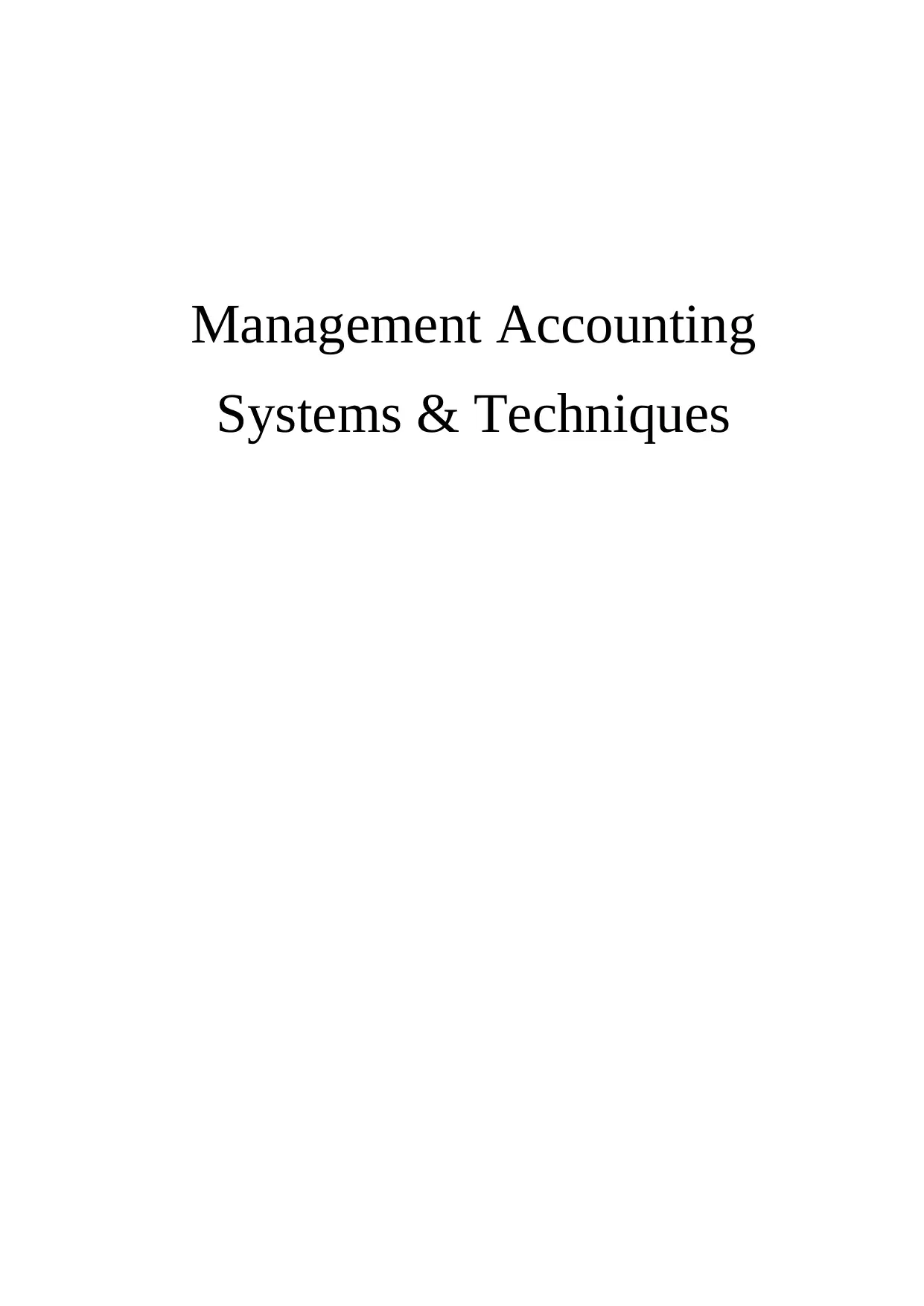
Management Accounting
Systems & Techniques
Systems & Techniques
Secure Best Marks with AI Grader
Need help grading? Try our AI Grader for instant feedback on your assignments.
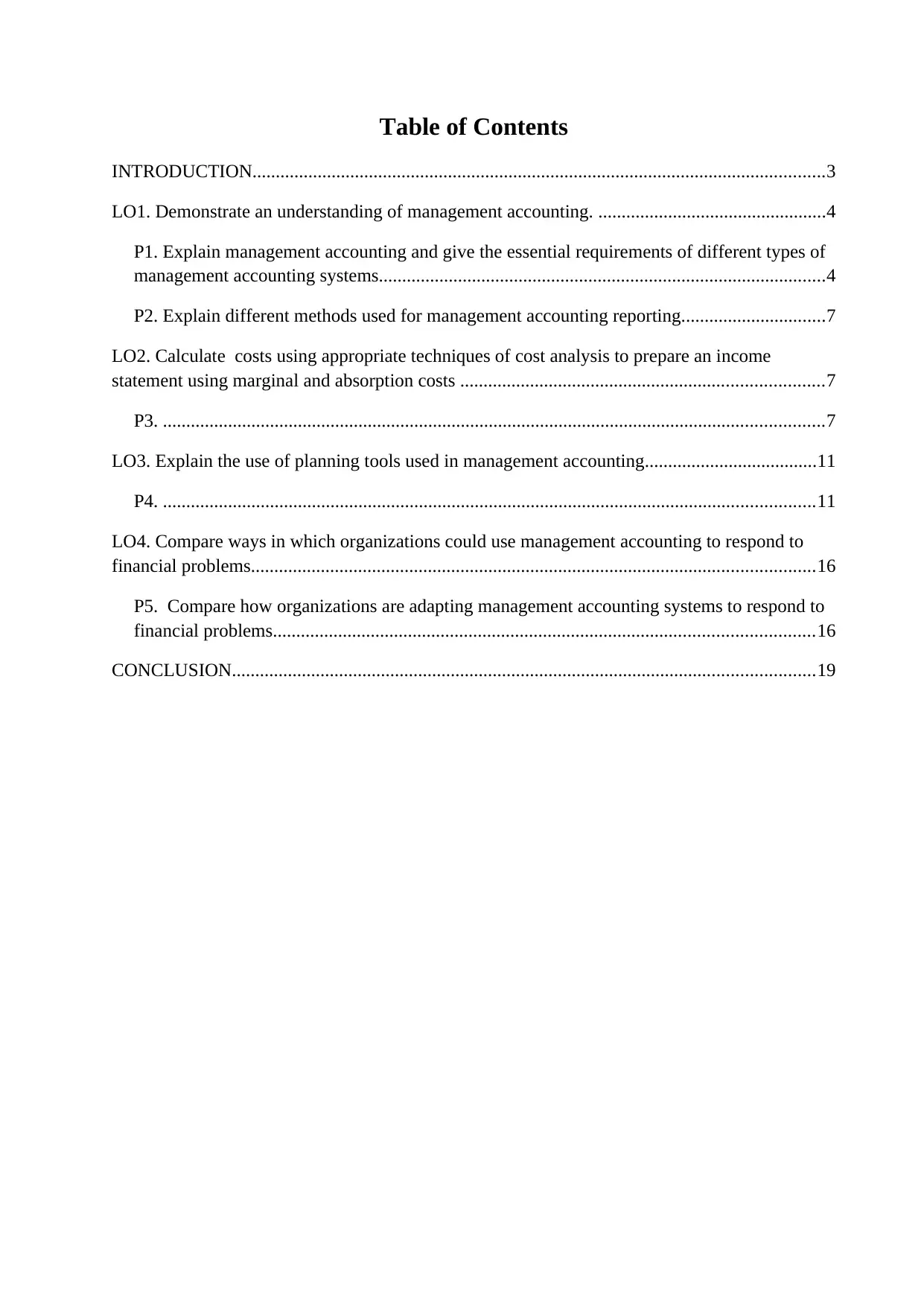
Table of Contents
INTRODUCTION...........................................................................................................................3
LO1. Demonstrate an understanding of management accounting. .................................................4
P1. Explain management accounting and give the essential requirements of different types of
management accounting systems................................................................................................4
P2. Explain different methods used for management accounting reporting...............................7
LO2. Calculate costs using appropriate techniques of cost analysis to prepare an income
statement using marginal and absorption costs ..............................................................................7
P3. ..............................................................................................................................................7
LO3. Explain the use of planning tools used in management accounting.....................................11
P4. ............................................................................................................................................11
LO4. Compare ways in which organizations could use management accounting to respond to
financial problems.........................................................................................................................16
P5. Compare how organizations are adapting management accounting systems to respond to
financial problems....................................................................................................................16
CONCLUSION.............................................................................................................................19
INTRODUCTION...........................................................................................................................3
LO1. Demonstrate an understanding of management accounting. .................................................4
P1. Explain management accounting and give the essential requirements of different types of
management accounting systems................................................................................................4
P2. Explain different methods used for management accounting reporting...............................7
LO2. Calculate costs using appropriate techniques of cost analysis to prepare an income
statement using marginal and absorption costs ..............................................................................7
P3. ..............................................................................................................................................7
LO3. Explain the use of planning tools used in management accounting.....................................11
P4. ............................................................................................................................................11
LO4. Compare ways in which organizations could use management accounting to respond to
financial problems.........................................................................................................................16
P5. Compare how organizations are adapting management accounting systems to respond to
financial problems....................................................................................................................16
CONCLUSION.............................................................................................................................19
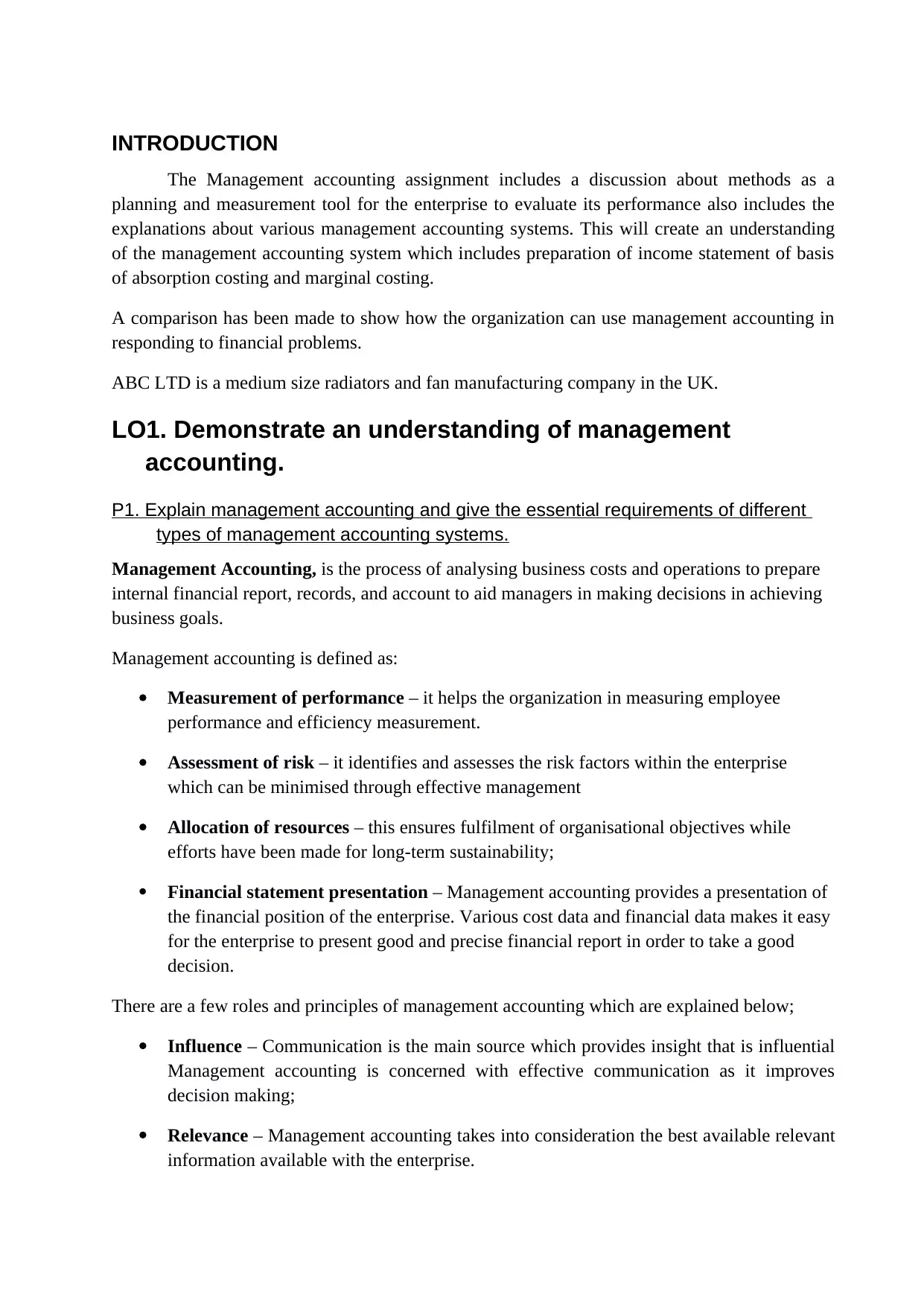
INTRODUCTION
The Management accounting assignment includes a discussion about methods as a
planning and measurement tool for the enterprise to evaluate its performance also includes the
explanations about various management accounting systems. This will create an understanding
of the management accounting system which includes preparation of income statement of basis
of absorption costing and marginal costing.
A comparison has been made to show how the organization can use management accounting in
responding to financial problems.
ABC LTD is a medium size radiators and fan manufacturing company in the UK.
LO1. Demonstrate an understanding of management
accounting.
P1. Explain management accounting and give the essential requirements of different
types of management accounting systems.
Management Accounting, is the process of analysing business costs and operations to prepare
internal financial report, records, and account to aid managers in making decisions in achieving
business goals.
Management accounting is defined as:
Measurement of performance – it helps the organization in measuring employee
performance and efficiency measurement.
Assessment of risk – it identifies and assesses the risk factors within the enterprise
which can be minimised through effective management
Allocation of resources – this ensures fulfilment of organisational objectives while
efforts have been made for long-term sustainability;
Financial statement presentation – Management accounting provides a presentation of
the financial position of the enterprise. Various cost data and financial data makes it easy
for the enterprise to present good and precise financial report in order to take a good
decision.
There are a few roles and principles of management accounting which are explained below;
Influence – Communication is the main source which provides insight that is influential
Management accounting is concerned with effective communication as it improves
decision making;
Relevance – Management accounting takes into consideration the best available relevant
information available with the enterprise.
The Management accounting assignment includes a discussion about methods as a
planning and measurement tool for the enterprise to evaluate its performance also includes the
explanations about various management accounting systems. This will create an understanding
of the management accounting system which includes preparation of income statement of basis
of absorption costing and marginal costing.
A comparison has been made to show how the organization can use management accounting in
responding to financial problems.
ABC LTD is a medium size radiators and fan manufacturing company in the UK.
LO1. Demonstrate an understanding of management
accounting.
P1. Explain management accounting and give the essential requirements of different
types of management accounting systems.
Management Accounting, is the process of analysing business costs and operations to prepare
internal financial report, records, and account to aid managers in making decisions in achieving
business goals.
Management accounting is defined as:
Measurement of performance – it helps the organization in measuring employee
performance and efficiency measurement.
Assessment of risk – it identifies and assesses the risk factors within the enterprise
which can be minimised through effective management
Allocation of resources – this ensures fulfilment of organisational objectives while
efforts have been made for long-term sustainability;
Financial statement presentation – Management accounting provides a presentation of
the financial position of the enterprise. Various cost data and financial data makes it easy
for the enterprise to present good and precise financial report in order to take a good
decision.
There are a few roles and principles of management accounting which are explained below;
Influence – Communication is the main source which provides insight that is influential
Management accounting is concerned with effective communication as it improves
decision making;
Relevance – Management accounting takes into consideration the best available relevant
information available with the enterprise.
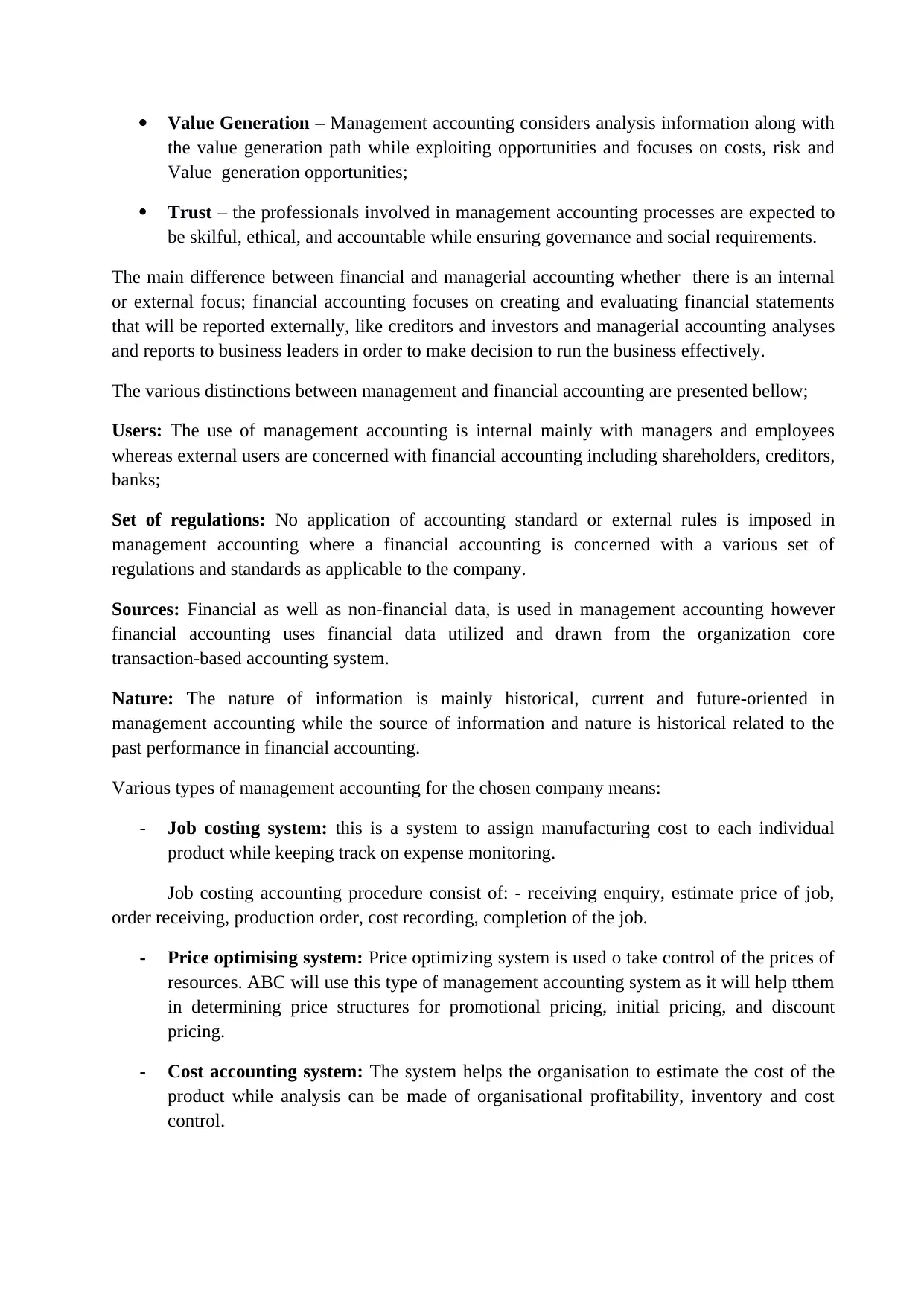
Value Generation – Management accounting considers analysis information along with
the value generation path while exploiting opportunities and focuses on costs, risk and
Value generation opportunities;
Trust – the professionals involved in management accounting processes are expected to
be skilful, ethical, and accountable while ensuring governance and social requirements.
The main difference between financial and managerial accounting whether there is an internal
or external focus; financial accounting focuses on creating and evaluating financial statements
that will be reported externally, like creditors and investors and managerial accounting analyses
and reports to business leaders in order to make decision to run the business effectively.
The various distinctions between management and financial accounting are presented bellow;
Users: The use of management accounting is internal mainly with managers and employees
whereas external users are concerned with financial accounting including shareholders, creditors,
banks;
Set of regulations: No application of accounting standard or external rules is imposed in
management accounting where a financial accounting is concerned with a various set of
regulations and standards as applicable to the company.
Sources: Financial as well as non-financial data, is used in management accounting however
financial accounting uses financial data utilized and drawn from the organization core
transaction-based accounting system.
Nature: The nature of information is mainly historical, current and future-oriented in
management accounting while the source of information and nature is historical related to the
past performance in financial accounting.
Various types of management accounting for the chosen company means:
- Job costing system: this is a system to assign manufacturing cost to each individual
product while keeping track on expense monitoring.
Job costing accounting procedure consist of: - receiving enquiry, estimate price of job,
order receiving, production order, cost recording, completion of the job.
- Price optimising system: Price optimizing system is used o take control of the prices of
resources. ABC will use this type of management accounting system as it will help tthem
in determining price structures for promotional pricing, initial pricing, and discount
pricing.
- Cost accounting system: The system helps the organisation to estimate the cost of the
product while analysis can be made of organisational profitability, inventory and cost
control.
the value generation path while exploiting opportunities and focuses on costs, risk and
Value generation opportunities;
Trust – the professionals involved in management accounting processes are expected to
be skilful, ethical, and accountable while ensuring governance and social requirements.
The main difference between financial and managerial accounting whether there is an internal
or external focus; financial accounting focuses on creating and evaluating financial statements
that will be reported externally, like creditors and investors and managerial accounting analyses
and reports to business leaders in order to make decision to run the business effectively.
The various distinctions between management and financial accounting are presented bellow;
Users: The use of management accounting is internal mainly with managers and employees
whereas external users are concerned with financial accounting including shareholders, creditors,
banks;
Set of regulations: No application of accounting standard or external rules is imposed in
management accounting where a financial accounting is concerned with a various set of
regulations and standards as applicable to the company.
Sources: Financial as well as non-financial data, is used in management accounting however
financial accounting uses financial data utilized and drawn from the organization core
transaction-based accounting system.
Nature: The nature of information is mainly historical, current and future-oriented in
management accounting while the source of information and nature is historical related to the
past performance in financial accounting.
Various types of management accounting for the chosen company means:
- Job costing system: this is a system to assign manufacturing cost to each individual
product while keeping track on expense monitoring.
Job costing accounting procedure consist of: - receiving enquiry, estimate price of job,
order receiving, production order, cost recording, completion of the job.
- Price optimising system: Price optimizing system is used o take control of the prices of
resources. ABC will use this type of management accounting system as it will help tthem
in determining price structures for promotional pricing, initial pricing, and discount
pricing.
- Cost accounting system: The system helps the organisation to estimate the cost of the
product while analysis can be made of organisational profitability, inventory and cost
control.
Secure Best Marks with AI Grader
Need help grading? Try our AI Grader for instant feedback on your assignments.
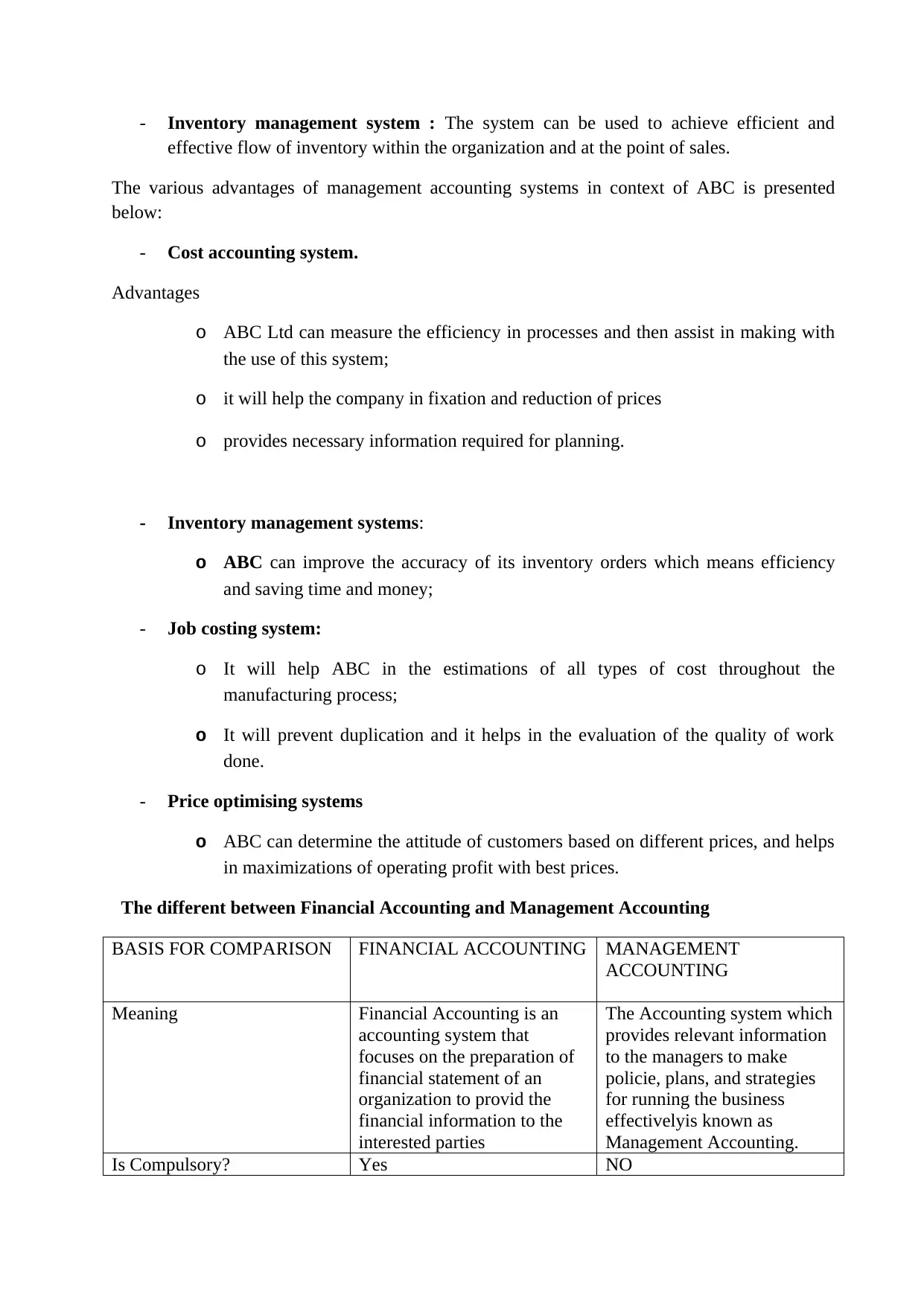
- Inventory management system : The system can be used to achieve efficient and
effective flow of inventory within the organization and at the point of sales.
The various advantages of management accounting systems in context of ABC is presented
below:
- Cost accounting system.
Advantages
o ABC Ltd can measure the efficiency in processes and then assist in making with
the use of this system;
o it will help the company in fixation and reduction of prices
o provides necessary information required for planning.
- Inventory management systems:
o ABC can improve the accuracy of its inventory orders which means efficiency
and saving time and money;
- Job costing system:
o It will help ABC in the estimations of all types of cost throughout the
manufacturing process;
o It will prevent duplication and it helps in the evaluation of the quality of work
done.
- Price optimising systems
o ABC can determine the attitude of customers based on different prices, and helps
in maximizations of operating profit with best prices.
The different between Financial Accounting and Management Accounting
BASIS FOR COMPARISON FINANCIAL ACCOUNTING MANAGEMENT
ACCOUNTING
Meaning Financial Accounting is an
accounting system that
focuses on the preparation of
financial statement of an
organization to provid the
financial information to the
interested parties
The Accounting system which
provides relevant information
to the managers to make
policie, plans, and strategies
for running the business
effectivelyis known as
Management Accounting.
Is Compulsory? Yes NO
effective flow of inventory within the organization and at the point of sales.
The various advantages of management accounting systems in context of ABC is presented
below:
- Cost accounting system.
Advantages
o ABC Ltd can measure the efficiency in processes and then assist in making with
the use of this system;
o it will help the company in fixation and reduction of prices
o provides necessary information required for planning.
- Inventory management systems:
o ABC can improve the accuracy of its inventory orders which means efficiency
and saving time and money;
- Job costing system:
o It will help ABC in the estimations of all types of cost throughout the
manufacturing process;
o It will prevent duplication and it helps in the evaluation of the quality of work
done.
- Price optimising systems
o ABC can determine the attitude of customers based on different prices, and helps
in maximizations of operating profit with best prices.
The different between Financial Accounting and Management Accounting
BASIS FOR COMPARISON FINANCIAL ACCOUNTING MANAGEMENT
ACCOUNTING
Meaning Financial Accounting is an
accounting system that
focuses on the preparation of
financial statement of an
organization to provid the
financial information to the
interested parties
The Accounting system which
provides relevant information
to the managers to make
policie, plans, and strategies
for running the business
effectivelyis known as
Management Accounting.
Is Compulsory? Yes NO
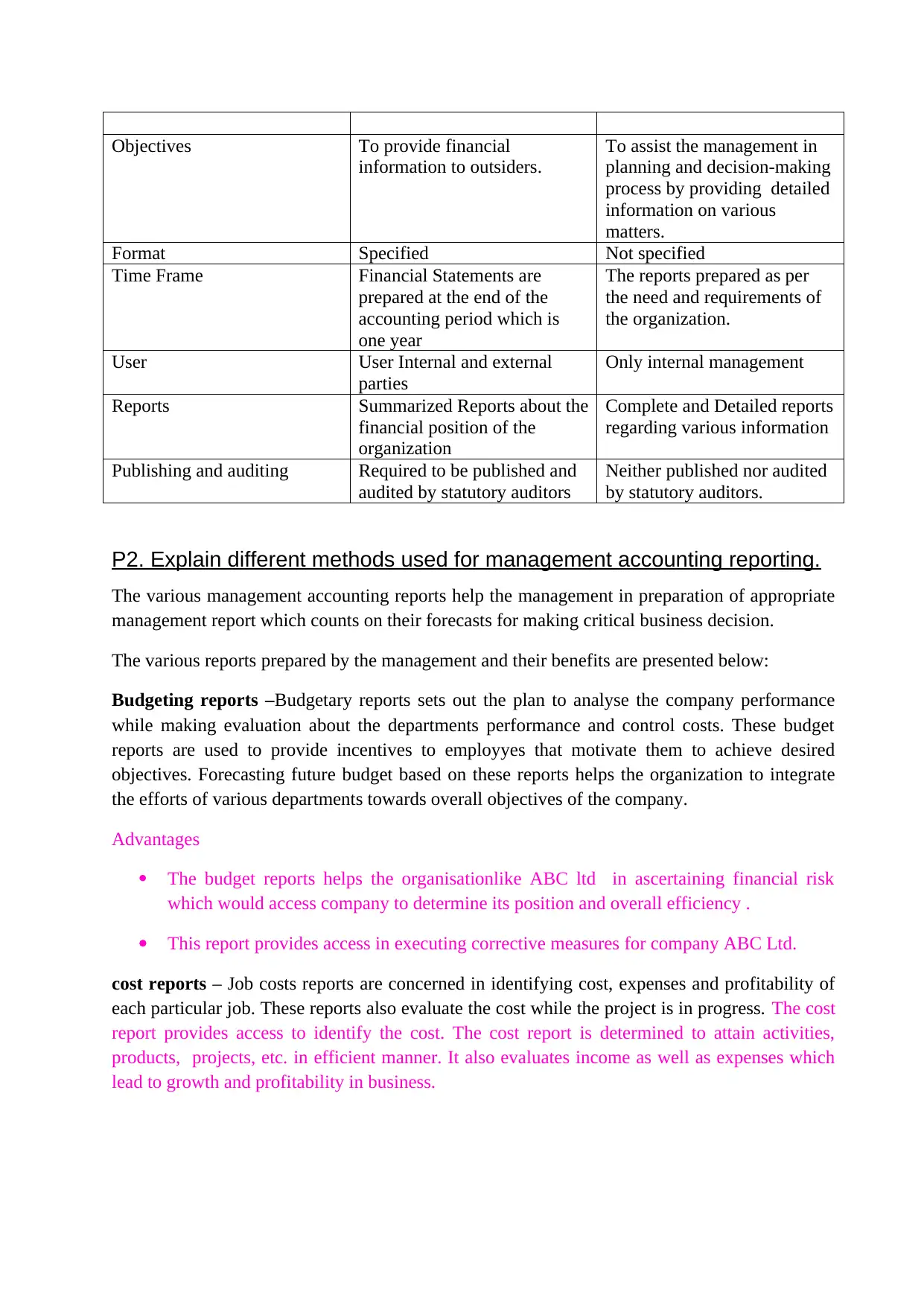
Objectives To provide financial
information to outsiders.
To assist the management in
planning and decision-making
process by providing detailed
information on various
matters.
Format Specified Not specified
Time Frame Financial Statements are
prepared at the end of the
accounting period which is
one year
The reports prepared as per
the need and requirements of
the organization.
User User Internal and external
parties
Only internal management
Reports Summarized Reports about the
financial position of the
organization
Complete and Detailed reports
regarding various information
Publishing and auditing Required to be published and
audited by statutory auditors
Neither published nor audited
by statutory auditors.
P2. Explain different methods used for management accounting reporting.
The various management accounting reports help the management in preparation of appropriate
management report which counts on their forecasts for making critical business decision.
The various reports prepared by the management and their benefits are presented below:
Budgeting reports –Budgetary reports sets out the plan to analyse the company performance
while making evaluation about the departments performance and control costs. These budget
reports are used to provide incentives to employyes that motivate them to achieve desired
objectives. Forecasting future budget based on these reports helps the organization to integrate
the efforts of various departments towards overall objectives of the company.
Advantages
The budget reports helps the organisationlike ABC ltd in ascertaining financial risk
which would access company to determine its position and overall efficiency .
This report provides access in executing corrective measures for company ABC Ltd.
cost reports – Job costs reports are concerned in identifying cost, expenses and profitability of
each particular job. These reports also evaluate the cost while the project is in progress. The cost
report provides access to identify the cost. The cost report is determined to attain activities,
products, projects, etc. in efficient manner. It also evaluates income as well as expenses which
lead to growth and profitability in business.
information to outsiders.
To assist the management in
planning and decision-making
process by providing detailed
information on various
matters.
Format Specified Not specified
Time Frame Financial Statements are
prepared at the end of the
accounting period which is
one year
The reports prepared as per
the need and requirements of
the organization.
User User Internal and external
parties
Only internal management
Reports Summarized Reports about the
financial position of the
organization
Complete and Detailed reports
regarding various information
Publishing and auditing Required to be published and
audited by statutory auditors
Neither published nor audited
by statutory auditors.
P2. Explain different methods used for management accounting reporting.
The various management accounting reports help the management in preparation of appropriate
management report which counts on their forecasts for making critical business decision.
The various reports prepared by the management and their benefits are presented below:
Budgeting reports –Budgetary reports sets out the plan to analyse the company performance
while making evaluation about the departments performance and control costs. These budget
reports are used to provide incentives to employyes that motivate them to achieve desired
objectives. Forecasting future budget based on these reports helps the organization to integrate
the efforts of various departments towards overall objectives of the company.
Advantages
The budget reports helps the organisationlike ABC ltd in ascertaining financial risk
which would access company to determine its position and overall efficiency .
This report provides access in executing corrective measures for company ABC Ltd.
cost reports – Job costs reports are concerned in identifying cost, expenses and profitability of
each particular job. These reports also evaluate the cost while the project is in progress. The cost
report provides access to identify the cost. The cost report is determined to attain activities,
products, projects, etc. in efficient manner. It also evaluates income as well as expenses which
lead to growth and profitability in business.
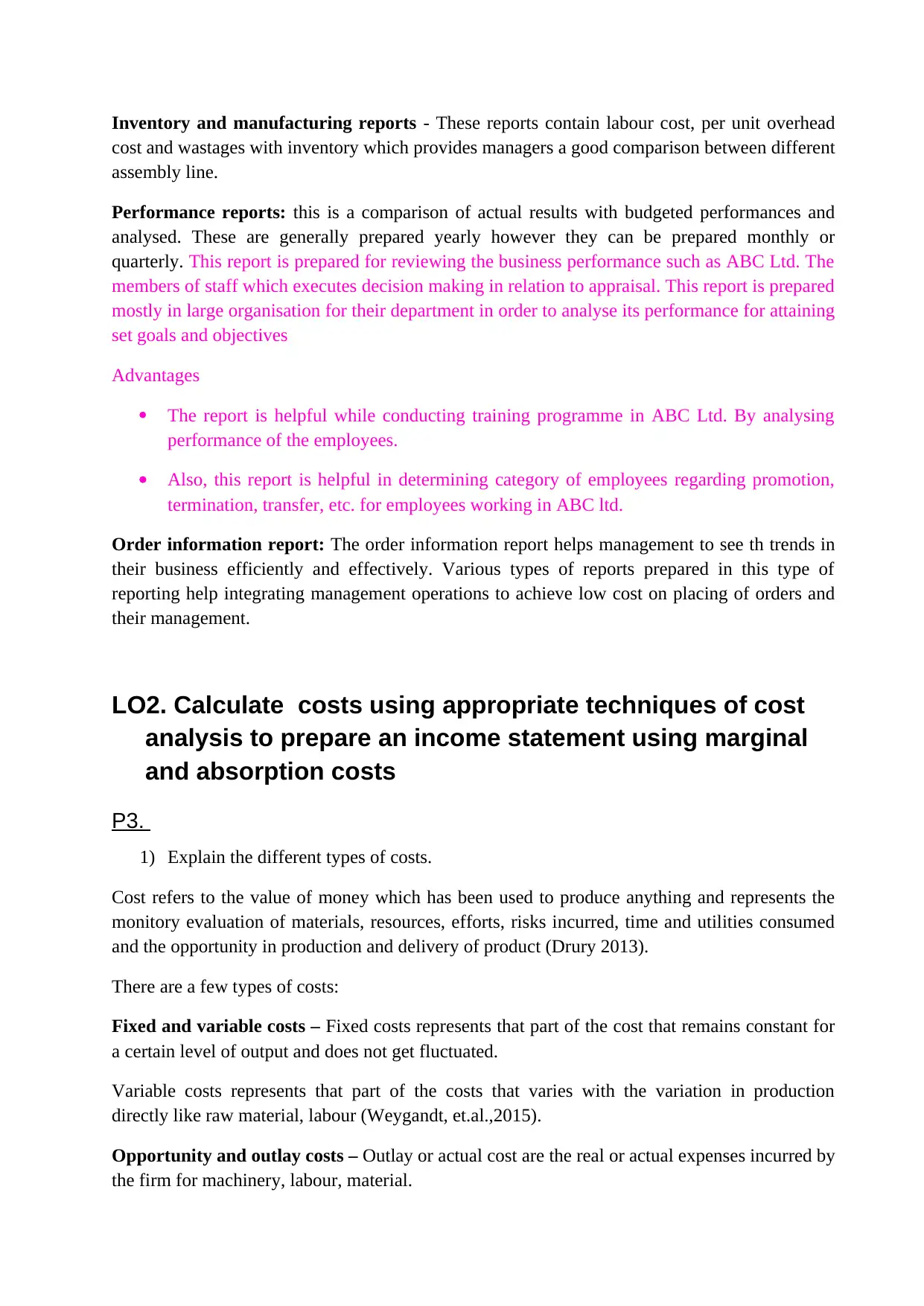
Inventory and manufacturing reports - These reports contain labour cost, per unit overhead
cost and wastages with inventory which provides managers a good comparison between different
assembly line.
Performance reports: this is a comparison of actual results with budgeted performances and
analysed. These are generally prepared yearly however they can be prepared monthly or
quarterly. This report is prepared for reviewing the business performance such as ABC Ltd. The
members of staff which executes decision making in relation to appraisal. This report is prepared
mostly in large organisation for their department in order to analyse its performance for attaining
set goals and objectives
Advantages
The report is helpful while conducting training programme in ABC Ltd. By analysing
performance of the employees.
Also, this report is helpful in determining category of employees regarding promotion,
termination, transfer, etc. for employees working in ABC ltd.
Order information report: The order information report helps management to see th trends in
their business efficiently and effectively. Various types of reports prepared in this type of
reporting help integrating management operations to achieve low cost on placing of orders and
their management.
LO2. Calculate costs using appropriate techniques of cost
analysis to prepare an income statement using marginal
and absorption costs
P3.
1) Explain the different types of costs.
Cost refers to the value of money which has been used to produce anything and represents the
monitory evaluation of materials, resources, efforts, risks incurred, time and utilities consumed
and the opportunity in production and delivery of product (Drury 2013).
There are a few types of costs:
Fixed and variable costs – Fixed costs represents that part of the cost that remains constant for
a certain level of output and does not get fluctuated.
Variable costs represents that part of the costs that varies with the variation in production
directly like raw material, labour (Weygandt, et.al.,2015).
Opportunity and outlay costs – Outlay or actual cost are the real or actual expenses incurred by
the firm for machinery, labour, material.
cost and wastages with inventory which provides managers a good comparison between different
assembly line.
Performance reports: this is a comparison of actual results with budgeted performances and
analysed. These are generally prepared yearly however they can be prepared monthly or
quarterly. This report is prepared for reviewing the business performance such as ABC Ltd. The
members of staff which executes decision making in relation to appraisal. This report is prepared
mostly in large organisation for their department in order to analyse its performance for attaining
set goals and objectives
Advantages
The report is helpful while conducting training programme in ABC Ltd. By analysing
performance of the employees.
Also, this report is helpful in determining category of employees regarding promotion,
termination, transfer, etc. for employees working in ABC ltd.
Order information report: The order information report helps management to see th trends in
their business efficiently and effectively. Various types of reports prepared in this type of
reporting help integrating management operations to achieve low cost on placing of orders and
their management.
LO2. Calculate costs using appropriate techniques of cost
analysis to prepare an income statement using marginal
and absorption costs
P3.
1) Explain the different types of costs.
Cost refers to the value of money which has been used to produce anything and represents the
monitory evaluation of materials, resources, efforts, risks incurred, time and utilities consumed
and the opportunity in production and delivery of product (Drury 2013).
There are a few types of costs:
Fixed and variable costs – Fixed costs represents that part of the cost that remains constant for
a certain level of output and does not get fluctuated.
Variable costs represents that part of the costs that varies with the variation in production
directly like raw material, labour (Weygandt, et.al.,2015).
Opportunity and outlay costs – Outlay or actual cost are the real or actual expenses incurred by
the firm for machinery, labour, material.
Paraphrase This Document
Need a fresh take? Get an instant paraphrase of this document with our AI Paraphraser
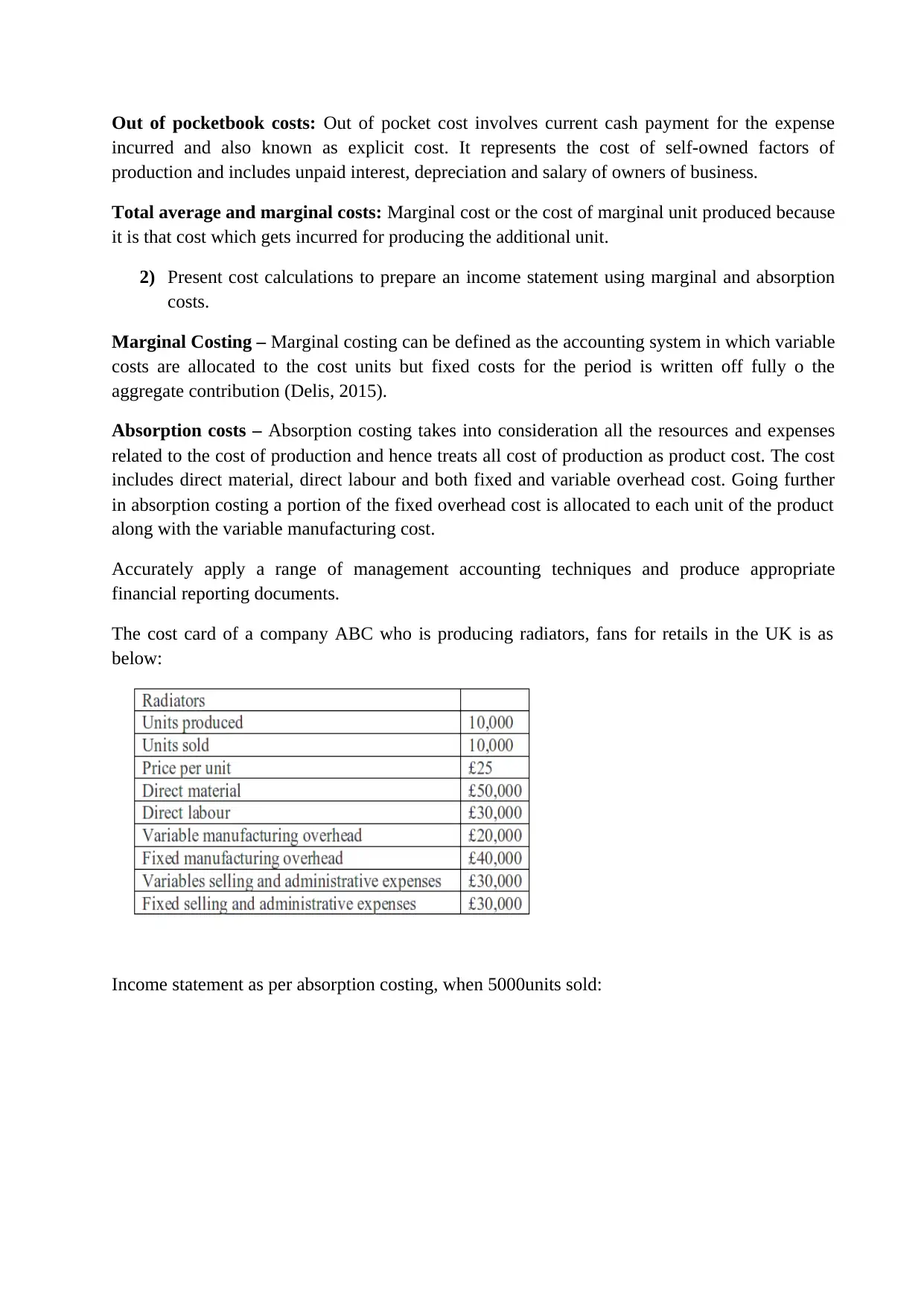
Out of pocketbook costs: Out of pocket cost involves current cash payment for the expense
incurred and also known as explicit cost. It represents the cost of self-owned factors of
production and includes unpaid interest, depreciation and salary of owners of business.
Total average and marginal costs: Marginal cost or the cost of marginal unit produced because
it is that cost which gets incurred for producing the additional unit.
2) Present cost calculations to prepare an income statement using marginal and absorption
costs.
Marginal Costing – Marginal costing can be defined as the accounting system in which variable
costs are allocated to the cost units but fixed costs for the period is written off fully o the
aggregate contribution (Delis, 2015).
Absorption costs – Absorption costing takes into consideration all the resources and expenses
related to the cost of production and hence treats all cost of production as product cost. The cost
includes direct material, direct labour and both fixed and variable overhead cost. Going further
in absorption costing a portion of the fixed overhead cost is allocated to each unit of the product
along with the variable manufacturing cost.
Accurately apply a range of management accounting techniques and produce appropriate
financial reporting documents.
The cost card of a company ABC who is producing radiators, fans for retails in the UK is as
below:
Income statement as per absorption costing, when 5000units sold:
incurred and also known as explicit cost. It represents the cost of self-owned factors of
production and includes unpaid interest, depreciation and salary of owners of business.
Total average and marginal costs: Marginal cost or the cost of marginal unit produced because
it is that cost which gets incurred for producing the additional unit.
2) Present cost calculations to prepare an income statement using marginal and absorption
costs.
Marginal Costing – Marginal costing can be defined as the accounting system in which variable
costs are allocated to the cost units but fixed costs for the period is written off fully o the
aggregate contribution (Delis, 2015).
Absorption costs – Absorption costing takes into consideration all the resources and expenses
related to the cost of production and hence treats all cost of production as product cost. The cost
includes direct material, direct labour and both fixed and variable overhead cost. Going further
in absorption costing a portion of the fixed overhead cost is allocated to each unit of the product
along with the variable manufacturing cost.
Accurately apply a range of management accounting techniques and produce appropriate
financial reporting documents.
The cost card of a company ABC who is producing radiators, fans for retails in the UK is as
below:
Income statement as per absorption costing, when 5000units sold:
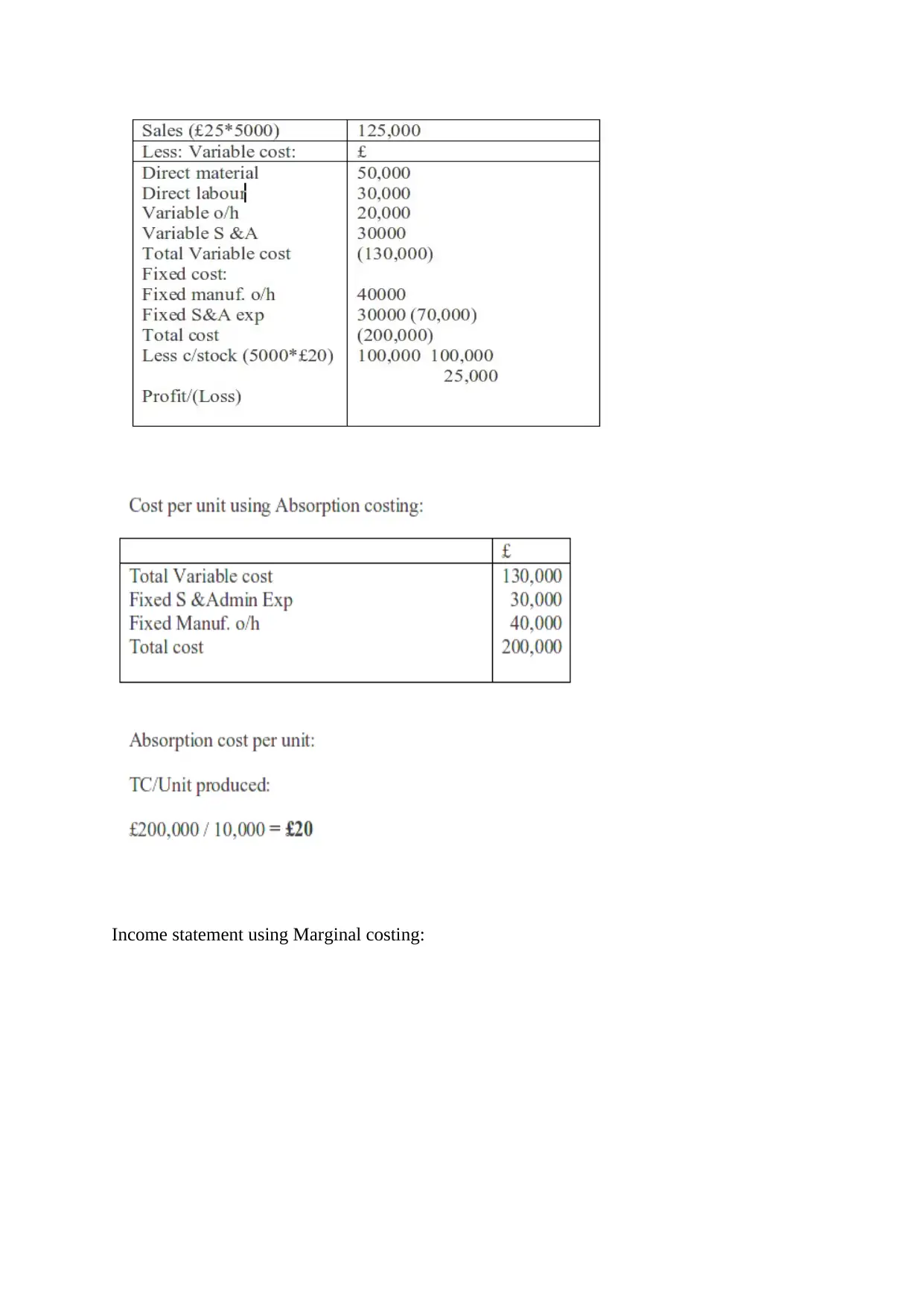
Income statement using Marginal costing:
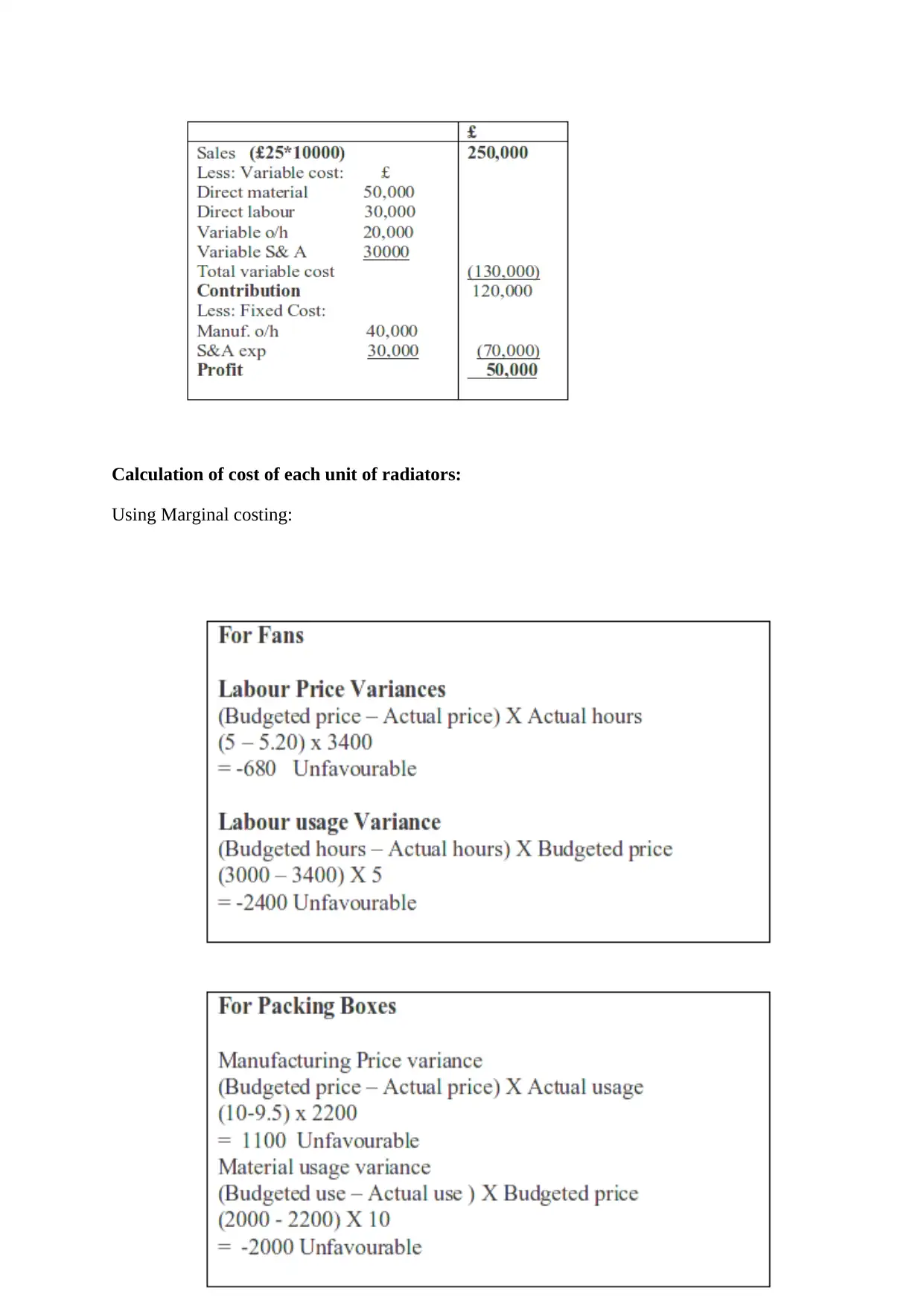
Calculation of cost of each unit of radiators:
Using Marginal costing:
Using Marginal costing:
Secure Best Marks with AI Grader
Need help grading? Try our AI Grader for instant feedback on your assignments.
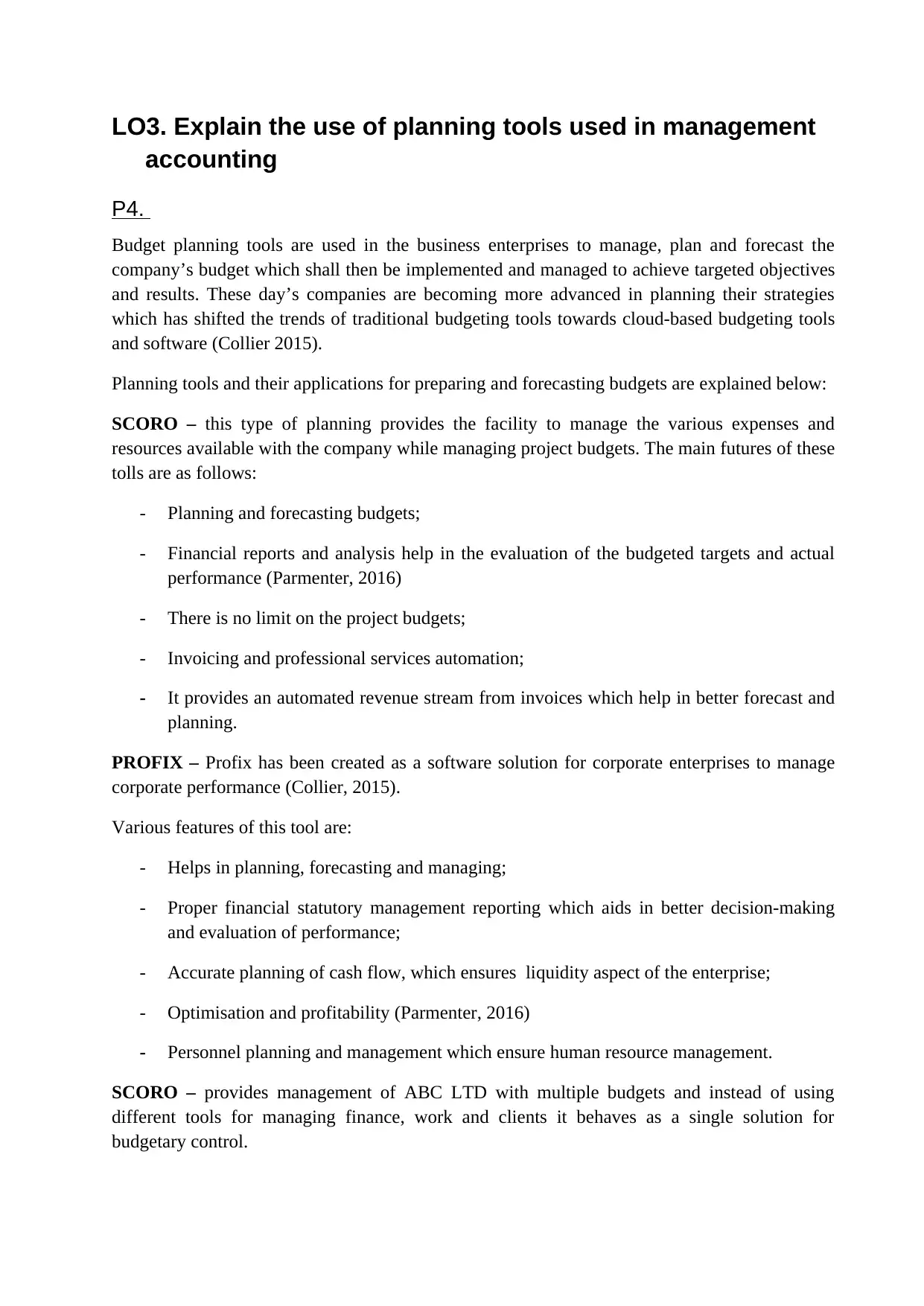
LO3. Explain the use of planning tools used in management
accounting
P4.
Budget planning tools are used in the business enterprises to manage, plan and forecast the
company’s budget which shall then be implemented and managed to achieve targeted objectives
and results. These day’s companies are becoming more advanced in planning their strategies
which has shifted the trends of traditional budgeting tools towards cloud-based budgeting tools
and software (Collier 2015).
Planning tools and their applications for preparing and forecasting budgets are explained below:
SCORO – this type of planning provides the facility to manage the various expenses and
resources available with the company while managing project budgets. The main futures of these
tolls are as follows:
- Planning and forecasting budgets;
- Financial reports and analysis help in the evaluation of the budgeted targets and actual
performance (Parmenter, 2016)
- There is no limit on the project budgets;
- Invoicing and professional services automation;
- It provides an automated revenue stream from invoices which help in better forecast and
planning.
PROFIX – Profix has been created as a software solution for corporate enterprises to manage
corporate performance (Collier, 2015).
Various features of this tool are:
- Helps in planning, forecasting and managing;
- Proper financial statutory management reporting which aids in better decision-making
and evaluation of performance;
- Accurate planning of cash flow, which ensures liquidity aspect of the enterprise;
- Optimisation and profitability (Parmenter, 2016)
- Personnel planning and management which ensure human resource management.
SCORO – provides management of ABC LTD with multiple budgets and instead of using
different tools for managing finance, work and clients it behaves as a single solution for
budgetary control.
accounting
P4.
Budget planning tools are used in the business enterprises to manage, plan and forecast the
company’s budget which shall then be implemented and managed to achieve targeted objectives
and results. These day’s companies are becoming more advanced in planning their strategies
which has shifted the trends of traditional budgeting tools towards cloud-based budgeting tools
and software (Collier 2015).
Planning tools and their applications for preparing and forecasting budgets are explained below:
SCORO – this type of planning provides the facility to manage the various expenses and
resources available with the company while managing project budgets. The main futures of these
tolls are as follows:
- Planning and forecasting budgets;
- Financial reports and analysis help in the evaluation of the budgeted targets and actual
performance (Parmenter, 2016)
- There is no limit on the project budgets;
- Invoicing and professional services automation;
- It provides an automated revenue stream from invoices which help in better forecast and
planning.
PROFIX – Profix has been created as a software solution for corporate enterprises to manage
corporate performance (Collier, 2015).
Various features of this tool are:
- Helps in planning, forecasting and managing;
- Proper financial statutory management reporting which aids in better decision-making
and evaluation of performance;
- Accurate planning of cash flow, which ensures liquidity aspect of the enterprise;
- Optimisation and profitability (Parmenter, 2016)
- Personnel planning and management which ensure human resource management.
SCORO – provides management of ABC LTD with multiple budgets and instead of using
different tools for managing finance, work and clients it behaves as a single solution for
budgetary control.
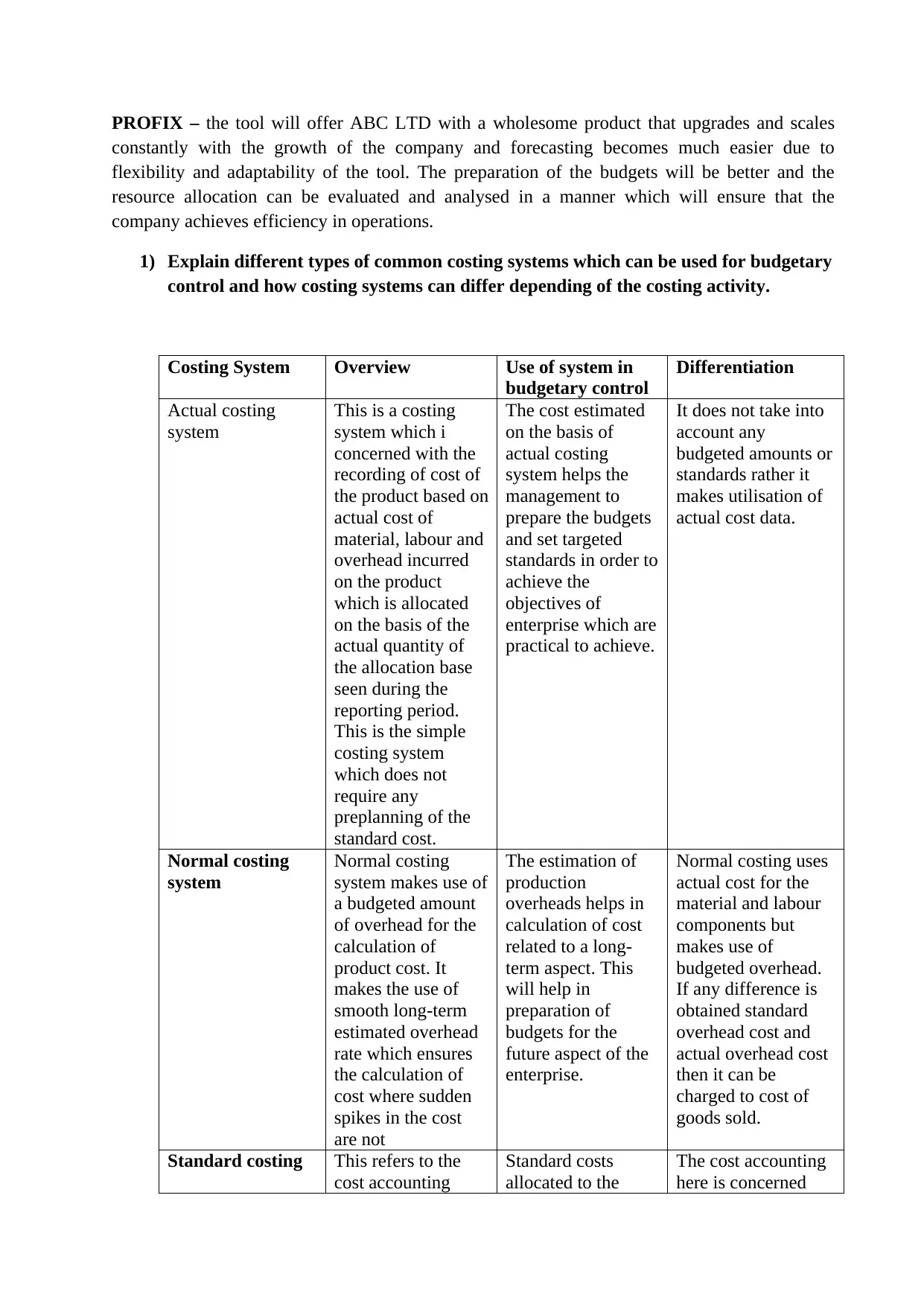
PROFIX – the tool will offer ABC LTD with a wholesome product that upgrades and scales
constantly with the growth of the company and forecasting becomes much easier due to
flexibility and adaptability of the tool. The preparation of the budgets will be better and the
resource allocation can be evaluated and analysed in a manner which will ensure that the
company achieves efficiency in operations.
1) Explain different types of common costing systems which can be used for budgetary
control and how costing systems can differ depending of the costing activity.
Costing System Overview Use of system in
budgetary control
Differentiation
Actual costing
system
This is a costing
system which i
concerned with the
recording of cost of
the product based on
actual cost of
material, labour and
overhead incurred
on the product
which is allocated
on the basis of the
actual quantity of
the allocation base
seen during the
reporting period.
This is the simple
costing system
which does not
require any
preplanning of the
standard cost.
The cost estimated
on the basis of
actual costing
system helps the
management to
prepare the budgets
and set targeted
standards in order to
achieve the
objectives of
enterprise which are
practical to achieve.
It does not take into
account any
budgeted amounts or
standards rather it
makes utilisation of
actual cost data.
Normal costing
system
Normal costing
system makes use of
a budgeted amount
of overhead for the
calculation of
product cost. It
makes the use of
smooth long-term
estimated overhead
rate which ensures
the calculation of
cost where sudden
spikes in the cost
are not
The estimation of
production
overheads helps in
calculation of cost
related to a long-
term aspect. This
will help in
preparation of
budgets for the
future aspect of the
enterprise.
Normal costing uses
actual cost for the
material and labour
components but
makes use of
budgeted overhead.
If any difference is
obtained standard
overhead cost and
actual overhead cost
then it can be
charged to cost of
goods sold.
Standard costing This refers to the
cost accounting
Standard costs
allocated to the
The cost accounting
here is concerned
constantly with the growth of the company and forecasting becomes much easier due to
flexibility and adaptability of the tool. The preparation of the budgets will be better and the
resource allocation can be evaluated and analysed in a manner which will ensure that the
company achieves efficiency in operations.
1) Explain different types of common costing systems which can be used for budgetary
control and how costing systems can differ depending of the costing activity.
Costing System Overview Use of system in
budgetary control
Differentiation
Actual costing
system
This is a costing
system which i
concerned with the
recording of cost of
the product based on
actual cost of
material, labour and
overhead incurred
on the product
which is allocated
on the basis of the
actual quantity of
the allocation base
seen during the
reporting period.
This is the simple
costing system
which does not
require any
preplanning of the
standard cost.
The cost estimated
on the basis of
actual costing
system helps the
management to
prepare the budgets
and set targeted
standards in order to
achieve the
objectives of
enterprise which are
practical to achieve.
It does not take into
account any
budgeted amounts or
standards rather it
makes utilisation of
actual cost data.
Normal costing
system
Normal costing
system makes use of
a budgeted amount
of overhead for the
calculation of
product cost. It
makes the use of
smooth long-term
estimated overhead
rate which ensures
the calculation of
cost where sudden
spikes in the cost
are not
The estimation of
production
overheads helps in
calculation of cost
related to a long-
term aspect. This
will help in
preparation of
budgets for the
future aspect of the
enterprise.
Normal costing uses
actual cost for the
material and labour
components but
makes use of
budgeted overhead.
If any difference is
obtained standard
overhead cost and
actual overhead cost
then it can be
charged to cost of
goods sold.
Standard costing This refers to the
cost accounting
Standard costs
allocated to the
The cost accounting
here is concerned
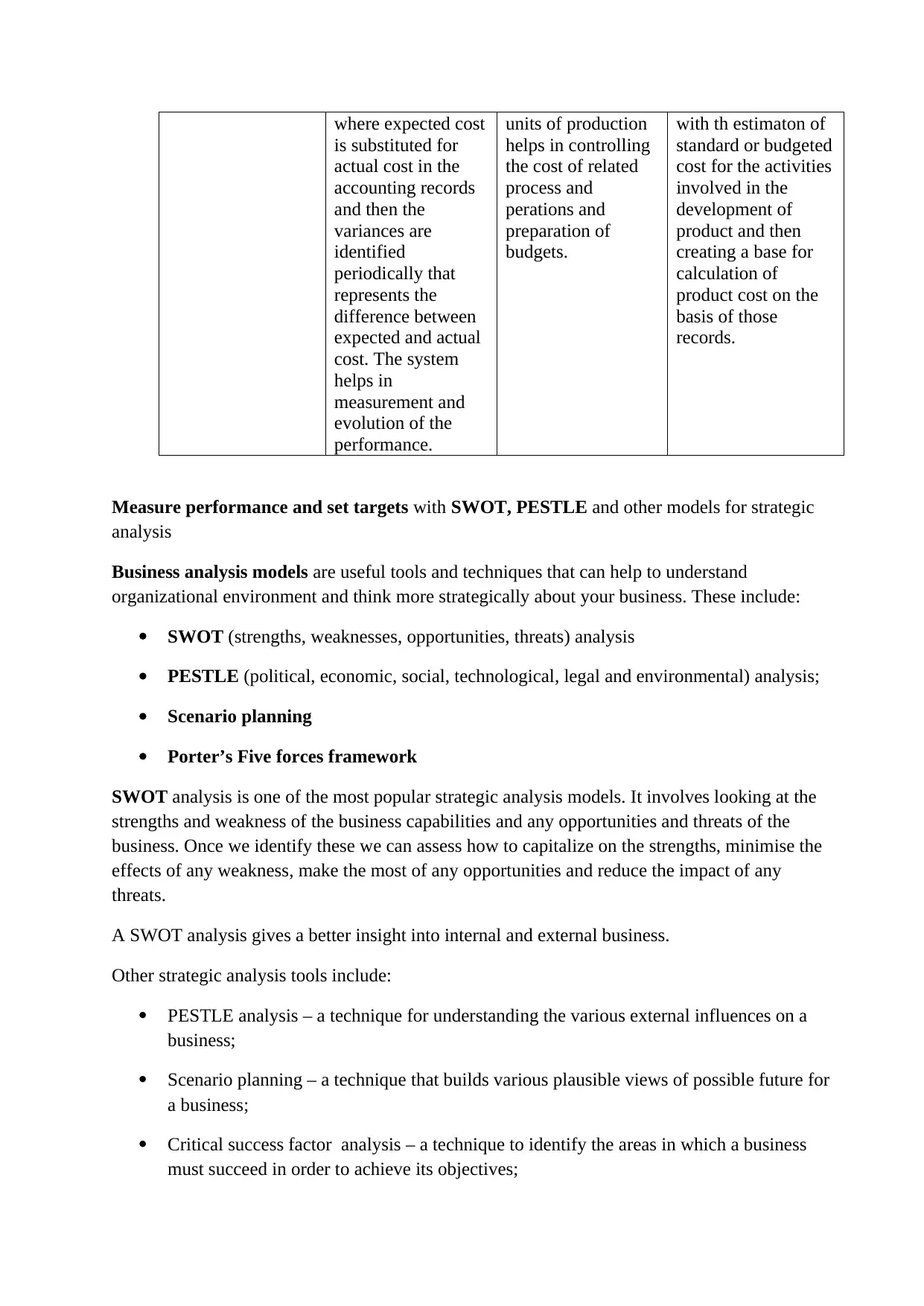
where expected cost
is substituted for
actual cost in the
accounting records
and then the
variances are
identified
periodically that
represents the
difference between
expected and actual
cost. The system
helps in
measurement and
evolution of the
performance.
units of production
helps in controlling
the cost of related
process and
perations and
preparation of
budgets.
with th estimaton of
standard or budgeted
cost for the activities
involved in the
development of
product and then
creating a base for
calculation of
product cost on the
basis of those
records.
Measure performance and set targets with SWOT, PESTLE and other models for strategic
analysis
Business analysis models are useful tools and techniques that can help to understand
organizational environment and think more strategically about your business. These include:
SWOT (strengths, weaknesses, opportunities, threats) analysis
PESTLE (political, economic, social, technological, legal and environmental) analysis;
Scenario planning
Porter’s Five forces framework
SWOT analysis is one of the most popular strategic analysis models. It involves looking at the
strengths and weakness of the business capabilities and any opportunities and threats of the
business. Once we identify these we can assess how to capitalize on the strengths, minimise the
effects of any weakness, make the most of any opportunities and reduce the impact of any
threats.
A SWOT analysis gives a better insight into internal and external business.
Other strategic analysis tools include:
PESTLE analysis – a technique for understanding the various external influences on a
business;
Scenario planning – a technique that builds various plausible views of possible future for
a business;
Critical success factor analysis – a technique to identify the areas in which a business
must succeed in order to achieve its objectives;
is substituted for
actual cost in the
accounting records
and then the
variances are
identified
periodically that
represents the
difference between
expected and actual
cost. The system
helps in
measurement and
evolution of the
performance.
units of production
helps in controlling
the cost of related
process and
perations and
preparation of
budgets.
with th estimaton of
standard or budgeted
cost for the activities
involved in the
development of
product and then
creating a base for
calculation of
product cost on the
basis of those
records.
Measure performance and set targets with SWOT, PESTLE and other models for strategic
analysis
Business analysis models are useful tools and techniques that can help to understand
organizational environment and think more strategically about your business. These include:
SWOT (strengths, weaknesses, opportunities, threats) analysis
PESTLE (political, economic, social, technological, legal and environmental) analysis;
Scenario planning
Porter’s Five forces framework
SWOT analysis is one of the most popular strategic analysis models. It involves looking at the
strengths and weakness of the business capabilities and any opportunities and threats of the
business. Once we identify these we can assess how to capitalize on the strengths, minimise the
effects of any weakness, make the most of any opportunities and reduce the impact of any
threats.
A SWOT analysis gives a better insight into internal and external business.
Other strategic analysis tools include:
PESTLE analysis – a technique for understanding the various external influences on a
business;
Scenario planning – a technique that builds various plausible views of possible future for
a business;
Critical success factor analysis – a technique to identify the areas in which a business
must succeed in order to achieve its objectives;
Paraphrase This Document
Need a fresh take? Get an instant paraphrase of this document with our AI Paraphraser
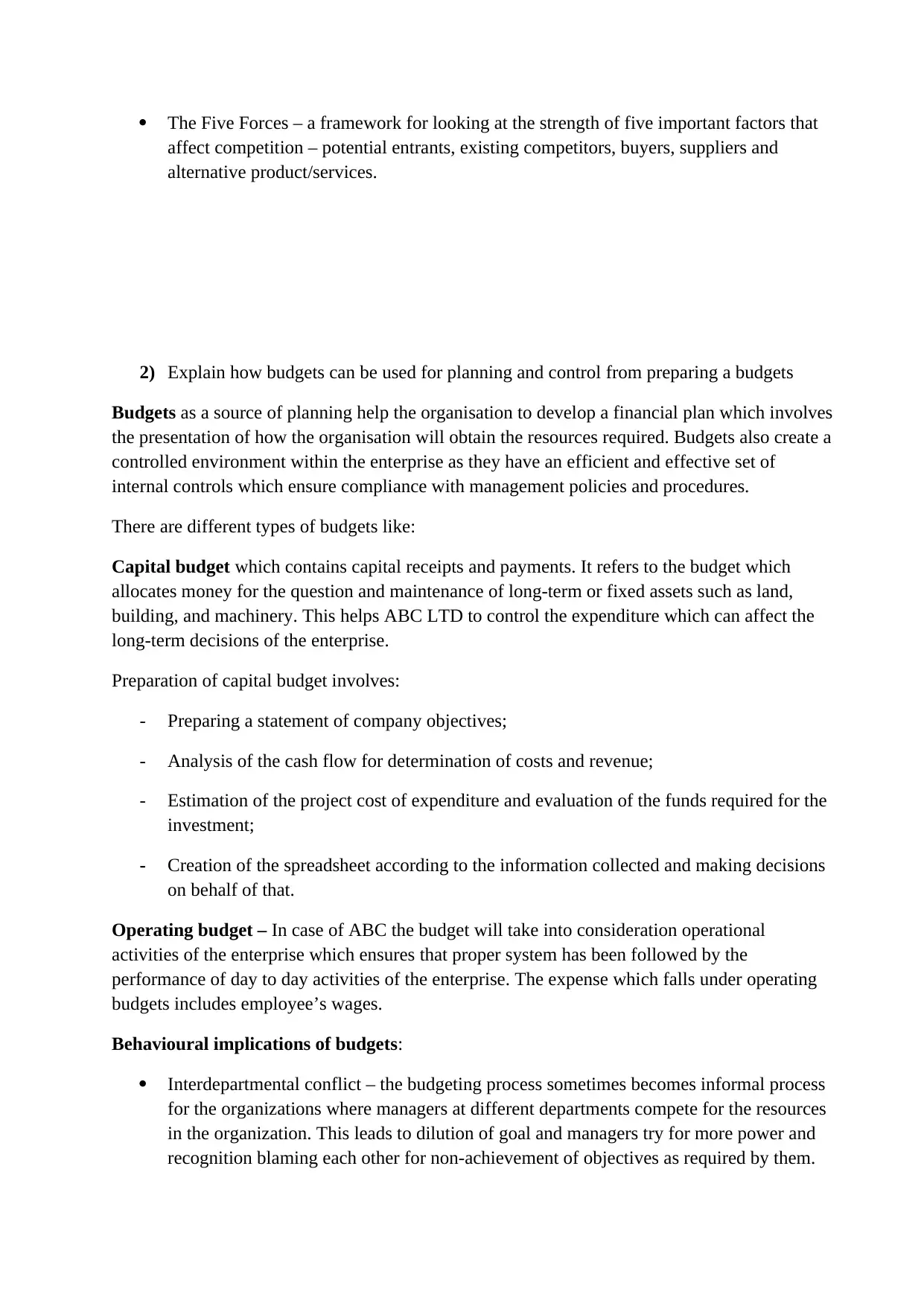
The Five Forces – a framework for looking at the strength of five important factors that
affect competition – potential entrants, existing competitors, buyers, suppliers and
alternative product/services.
2) Explain how budgets can be used for planning and control from preparing a budgets
Budgets as a source of planning help the organisation to develop a financial plan which involves
the presentation of how the organisation will obtain the resources required. Budgets also create a
controlled environment within the enterprise as they have an efficient and effective set of
internal controls which ensure compliance with management policies and procedures.
There are different types of budgets like:
Capital budget which contains capital receipts and payments. It refers to the budget which
allocates money for the question and maintenance of long-term or fixed assets such as land,
building, and machinery. This helps ABC LTD to control the expenditure which can affect the
long-term decisions of the enterprise.
Preparation of capital budget involves:
- Preparing a statement of company objectives;
- Analysis of the cash flow for determination of costs and revenue;
- Estimation of the project cost of expenditure and evaluation of the funds required for the
investment;
- Creation of the spreadsheet according to the information collected and making decisions
on behalf of that.
Operating budget – In case of ABC the budget will take into consideration operational
activities of the enterprise which ensures that proper system has been followed by the
performance of day to day activities of the enterprise. The expense which falls under operating
budgets includes employee’s wages.
Behavioural implications of budgets:
Interdepartmental conflict – the budgeting process sometimes becomes informal process
for the organizations where managers at different departments compete for the resources
in the organization. This leads to dilution of goal and managers try for more power and
recognition blaming each other for non-achievement of objectives as required by them.
affect competition – potential entrants, existing competitors, buyers, suppliers and
alternative product/services.
2) Explain how budgets can be used for planning and control from preparing a budgets
Budgets as a source of planning help the organisation to develop a financial plan which involves
the presentation of how the organisation will obtain the resources required. Budgets also create a
controlled environment within the enterprise as they have an efficient and effective set of
internal controls which ensure compliance with management policies and procedures.
There are different types of budgets like:
Capital budget which contains capital receipts and payments. It refers to the budget which
allocates money for the question and maintenance of long-term or fixed assets such as land,
building, and machinery. This helps ABC LTD to control the expenditure which can affect the
long-term decisions of the enterprise.
Preparation of capital budget involves:
- Preparing a statement of company objectives;
- Analysis of the cash flow for determination of costs and revenue;
- Estimation of the project cost of expenditure and evaluation of the funds required for the
investment;
- Creation of the spreadsheet according to the information collected and making decisions
on behalf of that.
Operating budget – In case of ABC the budget will take into consideration operational
activities of the enterprise which ensures that proper system has been followed by the
performance of day to day activities of the enterprise. The expense which falls under operating
budgets includes employee’s wages.
Behavioural implications of budgets:
Interdepartmental conflict – the budgeting process sometimes becomes informal process
for the organizations where managers at different departments compete for the resources
in the organization. This leads to dilution of goal and managers try for more power and
recognition blaming each other for non-achievement of objectives as required by them.
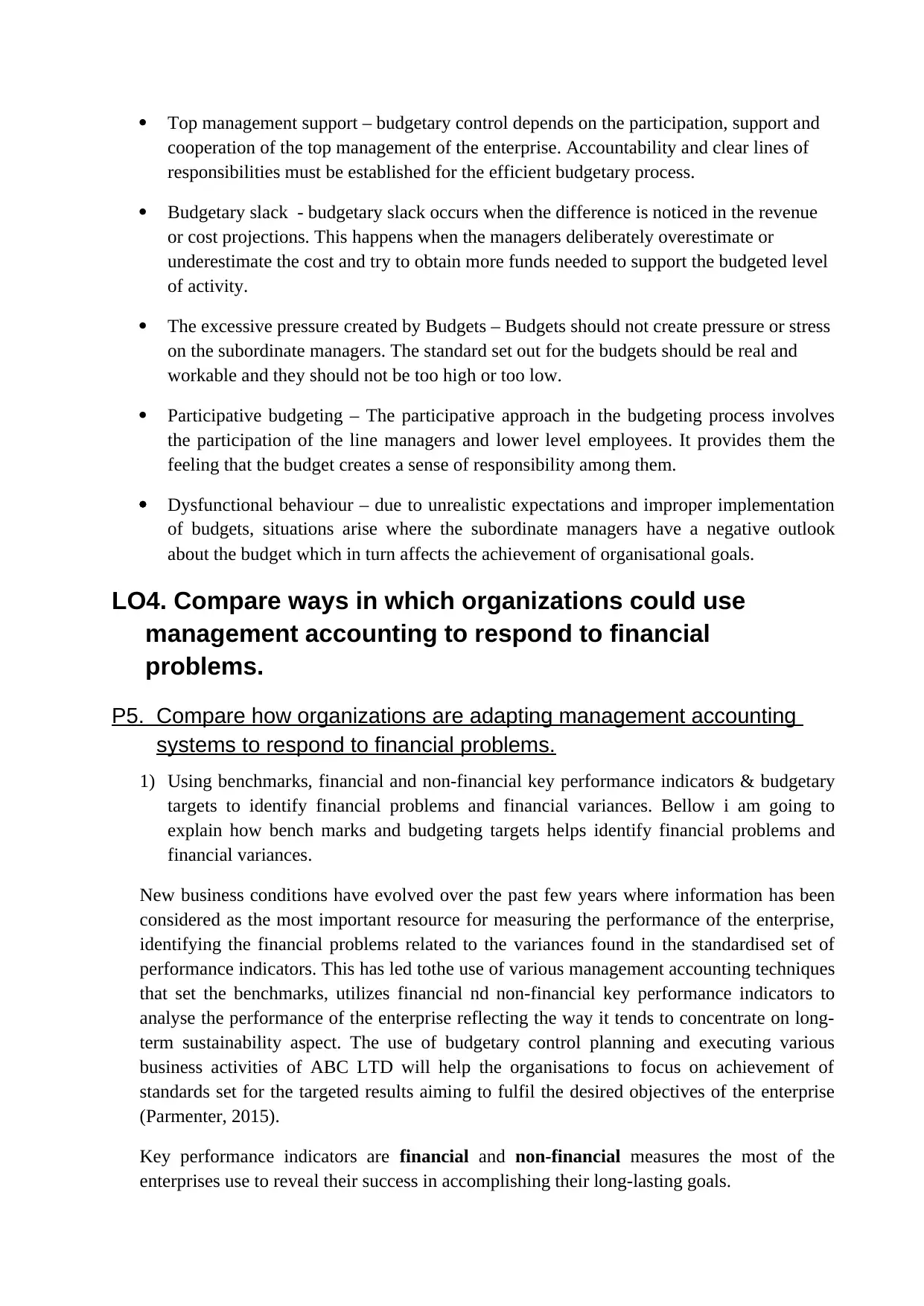
Top management support – budgetary control depends on the participation, support and
cooperation of the top management of the enterprise. Accountability and clear lines of
responsibilities must be established for the efficient budgetary process.
Budgetary slack - budgetary slack occurs when the difference is noticed in the revenue
or cost projections. This happens when the managers deliberately overestimate or
underestimate the cost and try to obtain more funds needed to support the budgeted level
of activity.
The excessive pressure created by Budgets – Budgets should not create pressure or stress
on the subordinate managers. The standard set out for the budgets should be real and
workable and they should not be too high or too low.
Participative budgeting – The participative approach in the budgeting process involves
the participation of the line managers and lower level employees. It provides them the
feeling that the budget creates a sense of responsibility among them.
Dysfunctional behaviour – due to unrealistic expectations and improper implementation
of budgets, situations arise where the subordinate managers have a negative outlook
about the budget which in turn affects the achievement of organisational goals.
LO4. Compare ways in which organizations could use
management accounting to respond to financial
problems.
P5. Compare how organizations are adapting management accounting
systems to respond to financial problems.
1) Using benchmarks, financial and non-financial key performance indicators & budgetary
targets to identify financial problems and financial variances. Bellow i am going to
explain how bench marks and budgeting targets helps identify financial problems and
financial variances.
New business conditions have evolved over the past few years where information has been
considered as the most important resource for measuring the performance of the enterprise,
identifying the financial problems related to the variances found in the standardised set of
performance indicators. This has led tothe use of various management accounting techniques
that set the benchmarks, utilizes financial nd non-financial key performance indicators to
analyse the performance of the enterprise reflecting the way it tends to concentrate on long-
term sustainability aspect. The use of budgetary control planning and executing various
business activities of ABC LTD will help the organisations to focus on achievement of
standards set for the targeted results aiming to fulfil the desired objectives of the enterprise
(Parmenter, 2015).
Key performance indicators are financial and non-financial measures the most of the
enterprises use to reveal their success in accomplishing their long-lasting goals.
cooperation of the top management of the enterprise. Accountability and clear lines of
responsibilities must be established for the efficient budgetary process.
Budgetary slack - budgetary slack occurs when the difference is noticed in the revenue
or cost projections. This happens when the managers deliberately overestimate or
underestimate the cost and try to obtain more funds needed to support the budgeted level
of activity.
The excessive pressure created by Budgets – Budgets should not create pressure or stress
on the subordinate managers. The standard set out for the budgets should be real and
workable and they should not be too high or too low.
Participative budgeting – The participative approach in the budgeting process involves
the participation of the line managers and lower level employees. It provides them the
feeling that the budget creates a sense of responsibility among them.
Dysfunctional behaviour – due to unrealistic expectations and improper implementation
of budgets, situations arise where the subordinate managers have a negative outlook
about the budget which in turn affects the achievement of organisational goals.
LO4. Compare ways in which organizations could use
management accounting to respond to financial
problems.
P5. Compare how organizations are adapting management accounting
systems to respond to financial problems.
1) Using benchmarks, financial and non-financial key performance indicators & budgetary
targets to identify financial problems and financial variances. Bellow i am going to
explain how bench marks and budgeting targets helps identify financial problems and
financial variances.
New business conditions have evolved over the past few years where information has been
considered as the most important resource for measuring the performance of the enterprise,
identifying the financial problems related to the variances found in the standardised set of
performance indicators. This has led tothe use of various management accounting techniques
that set the benchmarks, utilizes financial nd non-financial key performance indicators to
analyse the performance of the enterprise reflecting the way it tends to concentrate on long-
term sustainability aspect. The use of budgetary control planning and executing various
business activities of ABC LTD will help the organisations to focus on achievement of
standards set for the targeted results aiming to fulfil the desired objectives of the enterprise
(Parmenter, 2015).
Key performance indicators are financial and non-financial measures the most of the
enterprises use to reveal their success in accomplishing their long-lasting goals.
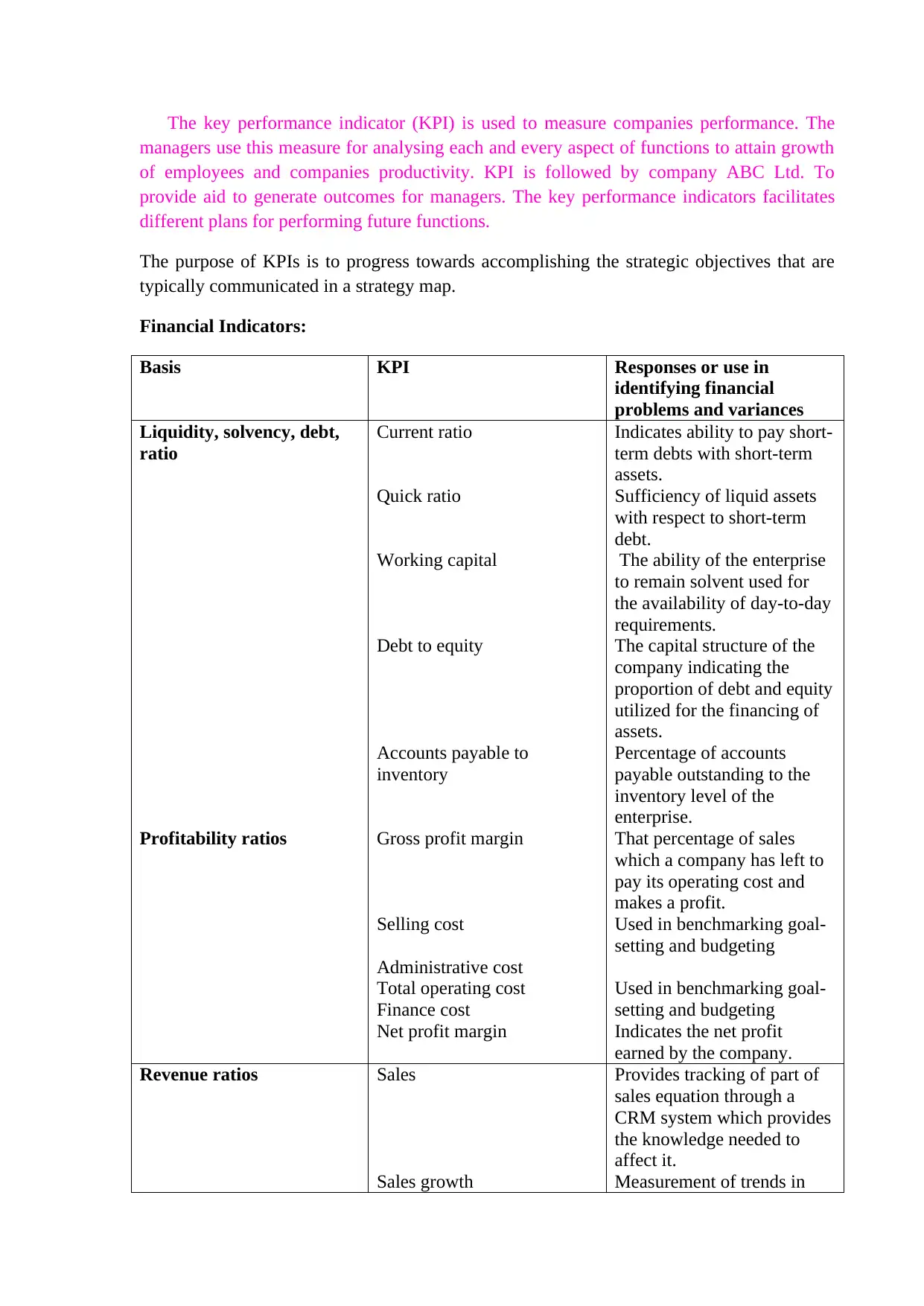
The key performance indicator (KPI) is used to measure companies performance. The
managers use this measure for analysing each and every aspect of functions to attain growth
of employees and companies productivity. KPI is followed by company ABC Ltd. To
provide aid to generate outcomes for managers. The key performance indicators facilitates
different plans for performing future functions.
The purpose of KPIs is to progress towards accomplishing the strategic objectives that are
typically communicated in a strategy map.
Financial Indicators:
Basis KPI Responses or use in
identifying financial
problems and variances
Liquidity, solvency, debt,
ratio
Profitability ratios
Current ratio
Quick ratio
Working capital
Debt to equity
Accounts payable to
inventory
Gross profit margin
Selling cost
Administrative cost
Total operating cost
Finance cost
Net profit margin
Indicates ability to pay short-
term debts with short-term
assets.
Sufficiency of liquid assets
with respect to short-term
debt.
The ability of the enterprise
to remain solvent used for
the availability of day-to-day
requirements.
The capital structure of the
company indicating the
proportion of debt and equity
utilized for the financing of
assets.
Percentage of accounts
payable outstanding to the
inventory level of the
enterprise.
That percentage of sales
which a company has left to
pay its operating cost and
makes a profit.
Used in benchmarking goal-
setting and budgeting
Used in benchmarking goal-
setting and budgeting
Indicates the net profit
earned by the company.
Revenue ratios Sales
Sales growth
Provides tracking of part of
sales equation through a
CRM system which provides
the knowledge needed to
affect it.
Measurement of trends in
managers use this measure for analysing each and every aspect of functions to attain growth
of employees and companies productivity. KPI is followed by company ABC Ltd. To
provide aid to generate outcomes for managers. The key performance indicators facilitates
different plans for performing future functions.
The purpose of KPIs is to progress towards accomplishing the strategic objectives that are
typically communicated in a strategy map.
Financial Indicators:
Basis KPI Responses or use in
identifying financial
problems and variances
Liquidity, solvency, debt,
ratio
Profitability ratios
Current ratio
Quick ratio
Working capital
Debt to equity
Accounts payable to
inventory
Gross profit margin
Selling cost
Administrative cost
Total operating cost
Finance cost
Net profit margin
Indicates ability to pay short-
term debts with short-term
assets.
Sufficiency of liquid assets
with respect to short-term
debt.
The ability of the enterprise
to remain solvent used for
the availability of day-to-day
requirements.
The capital structure of the
company indicating the
proportion of debt and equity
utilized for the financing of
assets.
Percentage of accounts
payable outstanding to the
inventory level of the
enterprise.
That percentage of sales
which a company has left to
pay its operating cost and
makes a profit.
Used in benchmarking goal-
setting and budgeting
Used in benchmarking goal-
setting and budgeting
Indicates the net profit
earned by the company.
Revenue ratios Sales
Sales growth
Provides tracking of part of
sales equation through a
CRM system which provides
the knowledge needed to
affect it.
Measurement of trends in
Secure Best Marks with AI Grader
Need help grading? Try our AI Grader for instant feedback on your assignments.
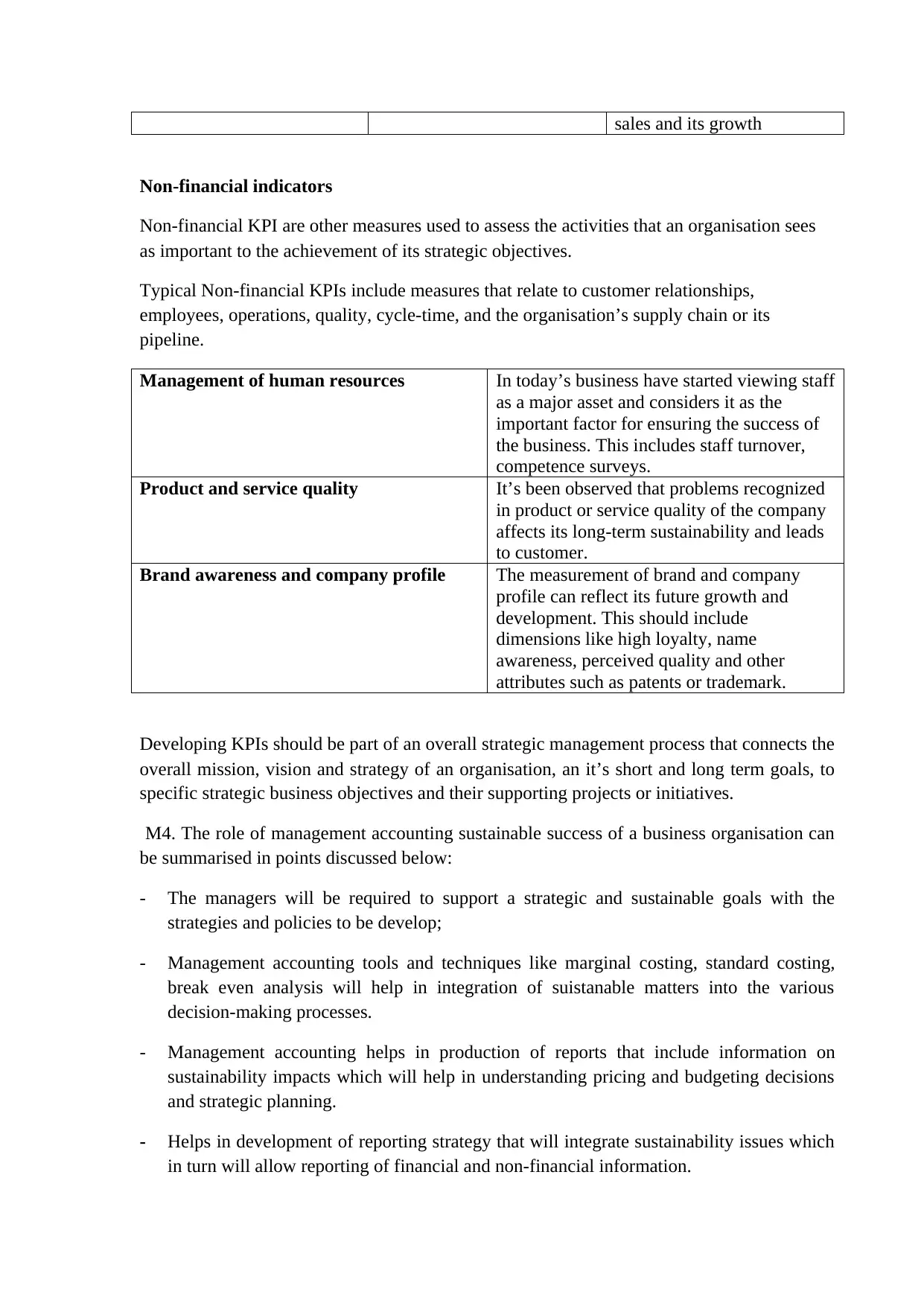
sales and its growth
Non-financial indicators
Non-financial KPI are other measures used to assess the activities that an organisation sees
as important to the achievement of its strategic objectives.
Typical Non-financial KPIs include measures that relate to customer relationships,
employees, operations, quality, cycle-time, and the organisation’s supply chain or its
pipeline.
Management of human resources In today’s business have started viewing staff
as a major asset and considers it as the
important factor for ensuring the success of
the business. This includes staff turnover,
competence surveys.
Product and service quality It’s been observed that problems recognized
in product or service quality of the company
affects its long-term sustainability and leads
to customer.
Brand awareness and company profile The measurement of brand and company
profile can reflect its future growth and
development. This should include
dimensions like high loyalty, name
awareness, perceived quality and other
attributes such as patents or trademark.
Developing KPIs should be part of an overall strategic management process that connects the
overall mission, vision and strategy of an organisation, an it’s short and long term goals, to
specific strategic business objectives and their supporting projects or initiatives.
M4. The role of management accounting sustainable success of a business organisation can
be summarised in points discussed below:
- The managers will be required to support a strategic and sustainable goals with the
strategies and policies to be develop;
- Management accounting tools and techniques like marginal costing, standard costing,
break even analysis will help in integration of suistanable matters into the various
decision-making processes.
- Management accounting helps in production of reports that include information on
sustainability impacts which will help in understanding pricing and budgeting decisions
and strategic planning.
- Helps in development of reporting strategy that will integrate sustainability issues which
in turn will allow reporting of financial and non-financial information.
Non-financial indicators
Non-financial KPI are other measures used to assess the activities that an organisation sees
as important to the achievement of its strategic objectives.
Typical Non-financial KPIs include measures that relate to customer relationships,
employees, operations, quality, cycle-time, and the organisation’s supply chain or its
pipeline.
Management of human resources In today’s business have started viewing staff
as a major asset and considers it as the
important factor for ensuring the success of
the business. This includes staff turnover,
competence surveys.
Product and service quality It’s been observed that problems recognized
in product or service quality of the company
affects its long-term sustainability and leads
to customer.
Brand awareness and company profile The measurement of brand and company
profile can reflect its future growth and
development. This should include
dimensions like high loyalty, name
awareness, perceived quality and other
attributes such as patents or trademark.
Developing KPIs should be part of an overall strategic management process that connects the
overall mission, vision and strategy of an organisation, an it’s short and long term goals, to
specific strategic business objectives and their supporting projects or initiatives.
M4. The role of management accounting sustainable success of a business organisation can
be summarised in points discussed below:
- The managers will be required to support a strategic and sustainable goals with the
strategies and policies to be develop;
- Management accounting tools and techniques like marginal costing, standard costing,
break even analysis will help in integration of suistanable matters into the various
decision-making processes.
- Management accounting helps in production of reports that include information on
sustainability impacts which will help in understanding pricing and budgeting decisions
and strategic planning.
- Helps in development of reporting strategy that will integrate sustainability issues which
in turn will allow reporting of financial and non-financial information.
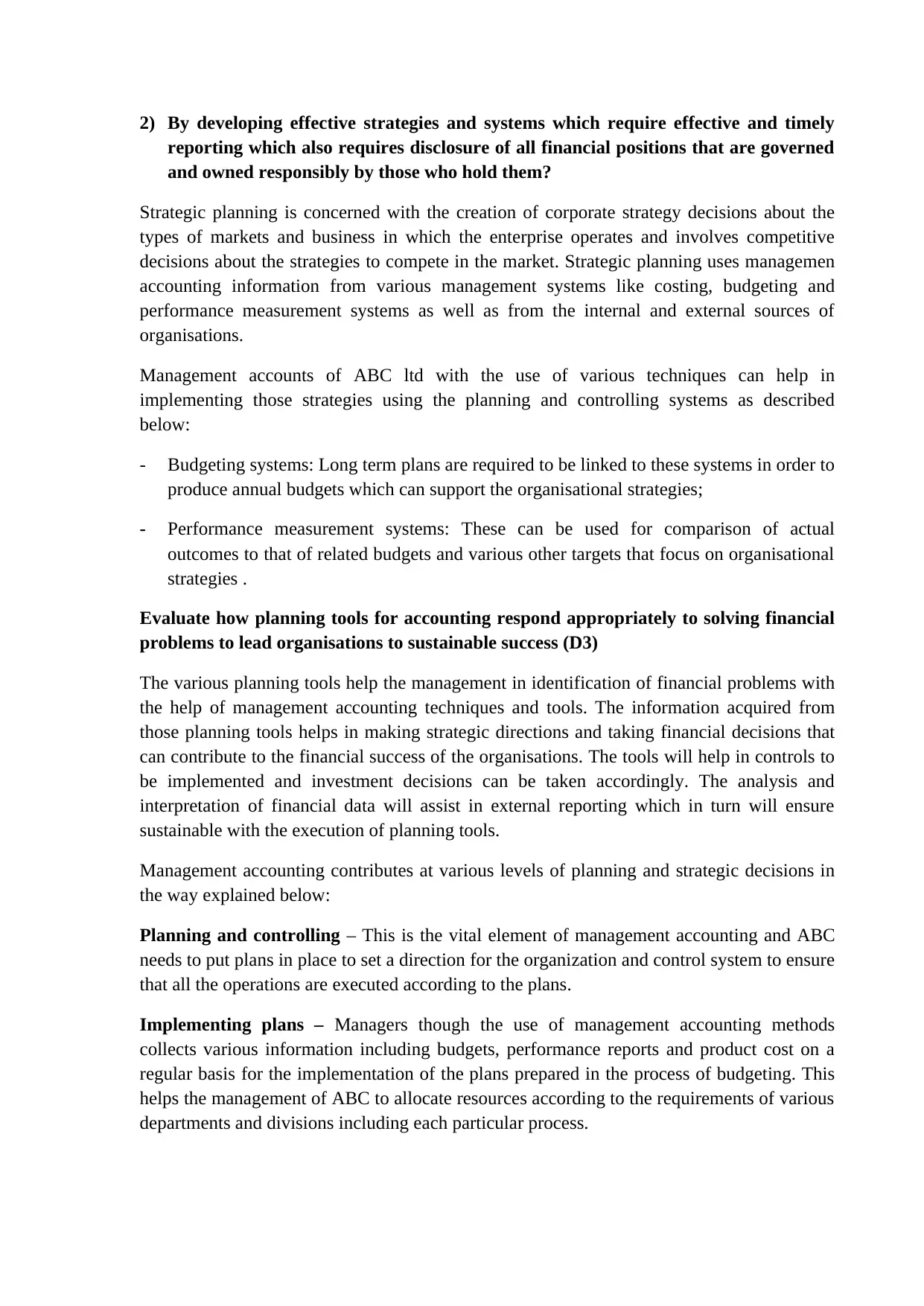
2) By developing effective strategies and systems which require effective and timely
reporting which also requires disclosure of all financial positions that are governed
and owned responsibly by those who hold them?
Strategic planning is concerned with the creation of corporate strategy decisions about the
types of markets and business in which the enterprise operates and involves competitive
decisions about the strategies to compete in the market. Strategic planning uses managemen
accounting information from various management systems like costing, budgeting and
performance measurement systems as well as from the internal and external sources of
organisations.
Management accounts of ABC ltd with the use of various techniques can help in
implementing those strategies using the planning and controlling systems as described
below:
- Budgeting systems: Long term plans are required to be linked to these systems in order to
produce annual budgets which can support the organisational strategies;
- Performance measurement systems: These can be used for comparison of actual
outcomes to that of related budgets and various other targets that focus on organisational
strategies .
Evaluate how planning tools for accounting respond appropriately to solving financial
problems to lead organisations to sustainable success (D3)
The various planning tools help the management in identification of financial problems with
the help of management accounting techniques and tools. The information acquired from
those planning tools helps in making strategic directions and taking financial decisions that
can contribute to the financial success of the organisations. The tools will help in controls to
be implemented and investment decisions can be taken accordingly. The analysis and
interpretation of financial data will assist in external reporting which in turn will ensure
sustainable with the execution of planning tools.
Management accounting contributes at various levels of planning and strategic decisions in
the way explained below:
Planning and controlling – This is the vital element of management accounting and ABC
needs to put plans in place to set a direction for the organization and control system to ensure
that all the operations are executed according to the plans.
Implementing plans – Managers though the use of management accounting methods
collects various information including budgets, performance reports and product cost on a
regular basis for the implementation of the plans prepared in the process of budgeting. This
helps the management of ABC to allocate resources according to the requirements of various
departments and divisions including each particular process.
reporting which also requires disclosure of all financial positions that are governed
and owned responsibly by those who hold them?
Strategic planning is concerned with the creation of corporate strategy decisions about the
types of markets and business in which the enterprise operates and involves competitive
decisions about the strategies to compete in the market. Strategic planning uses managemen
accounting information from various management systems like costing, budgeting and
performance measurement systems as well as from the internal and external sources of
organisations.
Management accounts of ABC ltd with the use of various techniques can help in
implementing those strategies using the planning and controlling systems as described
below:
- Budgeting systems: Long term plans are required to be linked to these systems in order to
produce annual budgets which can support the organisational strategies;
- Performance measurement systems: These can be used for comparison of actual
outcomes to that of related budgets and various other targets that focus on organisational
strategies .
Evaluate how planning tools for accounting respond appropriately to solving financial
problems to lead organisations to sustainable success (D3)
The various planning tools help the management in identification of financial problems with
the help of management accounting techniques and tools. The information acquired from
those planning tools helps in making strategic directions and taking financial decisions that
can contribute to the financial success of the organisations. The tools will help in controls to
be implemented and investment decisions can be taken accordingly. The analysis and
interpretation of financial data will assist in external reporting which in turn will ensure
sustainable with the execution of planning tools.
Management accounting contributes at various levels of planning and strategic decisions in
the way explained below:
Planning and controlling – This is the vital element of management accounting and ABC
needs to put plans in place to set a direction for the organization and control system to ensure
that all the operations are executed according to the plans.
Implementing plans – Managers though the use of management accounting methods
collects various information including budgets, performance reports and product cost on a
regular basis for the implementation of the plans prepared in the process of budgeting. This
helps the management of ABC to allocate resources according to the requirements of various
departments and divisions including each particular process.
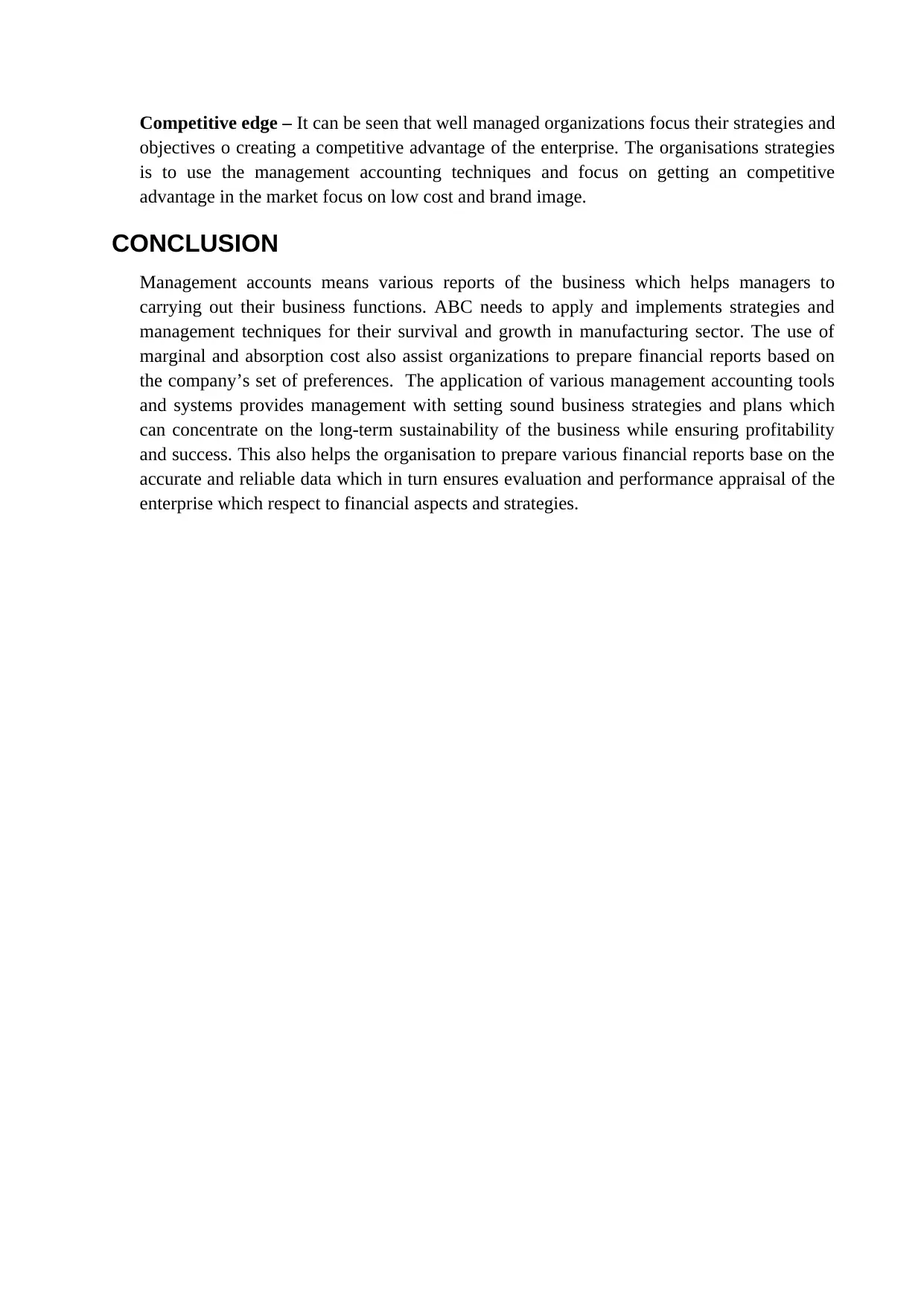
Competitive edge – It can be seen that well managed organizations focus their strategies and
objectives o creating a competitive advantage of the enterprise. The organisations strategies
is to use the management accounting techniques and focus on getting an competitive
advantage in the market focus on low cost and brand image.
CONCLUSION
Management accounts means various reports of the business which helps managers to
carrying out their business functions. ABC needs to apply and implements strategies and
management techniques for their survival and growth in manufacturing sector. The use of
marginal and absorption cost also assist organizations to prepare financial reports based on
the company’s set of preferences. The application of various management accounting tools
and systems provides management with setting sound business strategies and plans which
can concentrate on the long-term sustainability of the business while ensuring profitability
and success. This also helps the organisation to prepare various financial reports base on the
accurate and reliable data which in turn ensures evaluation and performance appraisal of the
enterprise which respect to financial aspects and strategies.
objectives o creating a competitive advantage of the enterprise. The organisations strategies
is to use the management accounting techniques and focus on getting an competitive
advantage in the market focus on low cost and brand image.
CONCLUSION
Management accounts means various reports of the business which helps managers to
carrying out their business functions. ABC needs to apply and implements strategies and
management techniques for their survival and growth in manufacturing sector. The use of
marginal and absorption cost also assist organizations to prepare financial reports based on
the company’s set of preferences. The application of various management accounting tools
and systems provides management with setting sound business strategies and plans which
can concentrate on the long-term sustainability of the business while ensuring profitability
and success. This also helps the organisation to prepare various financial reports base on the
accurate and reliable data which in turn ensures evaluation and performance appraisal of the
enterprise which respect to financial aspects and strategies.
Paraphrase This Document
Need a fresh take? Get an instant paraphrase of this document with our AI Paraphraser
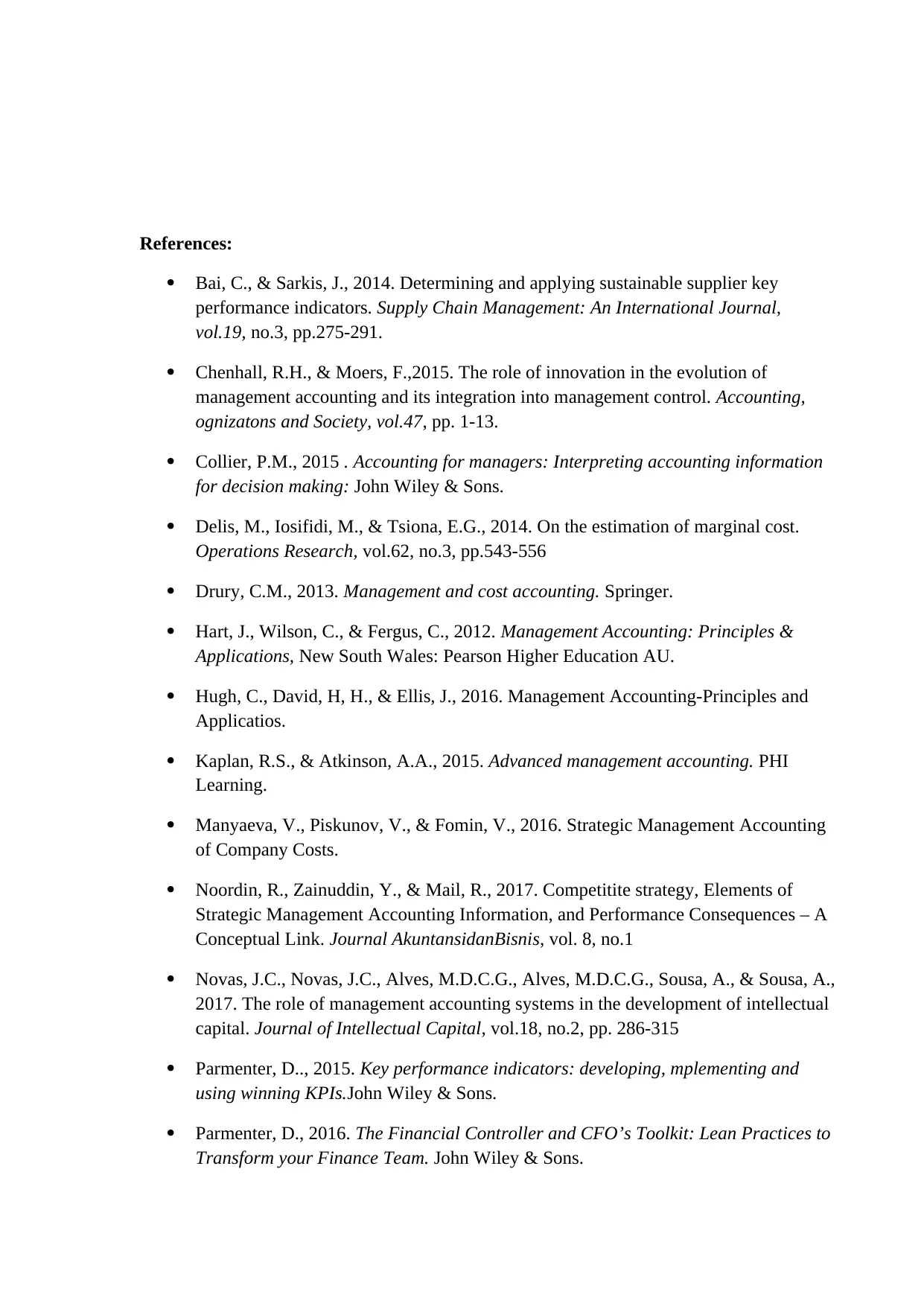
References:
Bai, C., & Sarkis, J., 2014. Determining and applying sustainable supplier key
performance indicators. Supply Chain Management: An International Journal,
vol.19, no.3, pp.275-291.
Chenhall, R.H., & Moers, F.,2015. The role of innovation in the evolution of
management accounting and its integration into management control. Accounting,
ognizatons and Society, vol.47, pp. 1-13.
Collier, P.M., 2015 . Accounting for managers: Interpreting accounting information
for decision making: John Wiley & Sons.
Delis, M., Iosifidi, M., & Tsiona, E.G., 2014. On the estimation of marginal cost.
Operations Research, vol.62, no.3, pp.543-556
Drury, C.M., 2013. Management and cost accounting. Springer.
Hart, J., Wilson, C., & Fergus, C., 2012. Management Accounting: Principles &
Applications, New South Wales: Pearson Higher Education AU.
Hugh, C., David, H, H., & Ellis, J., 2016. Management Accounting-Principles and
Applicatios.
Kaplan, R.S., & Atkinson, A.A., 2015. Advanced management accounting. PHI
Learning.
Manyaeva, V., Piskunov, V., & Fomin, V., 2016. Strategic Management Accounting
of Company Costs.
Noordin, R., Zainuddin, Y., & Mail, R., 2017. Competitite strategy, Elements of
Strategic Management Accounting Information, and Performance Consequences – A
Conceptual Link. Journal AkuntansidanBisnis, vol. 8, no.1
Novas, J.C., Novas, J.C., Alves, M.D.C.G., Alves, M.D.C.G., Sousa, A., & Sousa, A.,
2017. The role of management accounting systems in the development of intellectual
capital. Journal of Intellectual Capital, vol.18, no.2, pp. 286-315
Parmenter, D.., 2015. Key performance indicators: developing, mplementing and
using winning KPIs.John Wiley & Sons.
Parmenter, D., 2016. The Financial Controller and CFO’s Toolkit: Lean Practices to
Transform your Finance Team. John Wiley & Sons.
Bai, C., & Sarkis, J., 2014. Determining and applying sustainable supplier key
performance indicators. Supply Chain Management: An International Journal,
vol.19, no.3, pp.275-291.
Chenhall, R.H., & Moers, F.,2015. The role of innovation in the evolution of
management accounting and its integration into management control. Accounting,
ognizatons and Society, vol.47, pp. 1-13.
Collier, P.M., 2015 . Accounting for managers: Interpreting accounting information
for decision making: John Wiley & Sons.
Delis, M., Iosifidi, M., & Tsiona, E.G., 2014. On the estimation of marginal cost.
Operations Research, vol.62, no.3, pp.543-556
Drury, C.M., 2013. Management and cost accounting. Springer.
Hart, J., Wilson, C., & Fergus, C., 2012. Management Accounting: Principles &
Applications, New South Wales: Pearson Higher Education AU.
Hugh, C., David, H, H., & Ellis, J., 2016. Management Accounting-Principles and
Applicatios.
Kaplan, R.S., & Atkinson, A.A., 2015. Advanced management accounting. PHI
Learning.
Manyaeva, V., Piskunov, V., & Fomin, V., 2016. Strategic Management Accounting
of Company Costs.
Noordin, R., Zainuddin, Y., & Mail, R., 2017. Competitite strategy, Elements of
Strategic Management Accounting Information, and Performance Consequences – A
Conceptual Link. Journal AkuntansidanBisnis, vol. 8, no.1
Novas, J.C., Novas, J.C., Alves, M.D.C.G., Alves, M.D.C.G., Sousa, A., & Sousa, A.,
2017. The role of management accounting systems in the development of intellectual
capital. Journal of Intellectual Capital, vol.18, no.2, pp. 286-315
Parmenter, D.., 2015. Key performance indicators: developing, mplementing and
using winning KPIs.John Wiley & Sons.
Parmenter, D., 2016. The Financial Controller and CFO’s Toolkit: Lean Practices to
Transform your Finance Team. John Wiley & Sons.
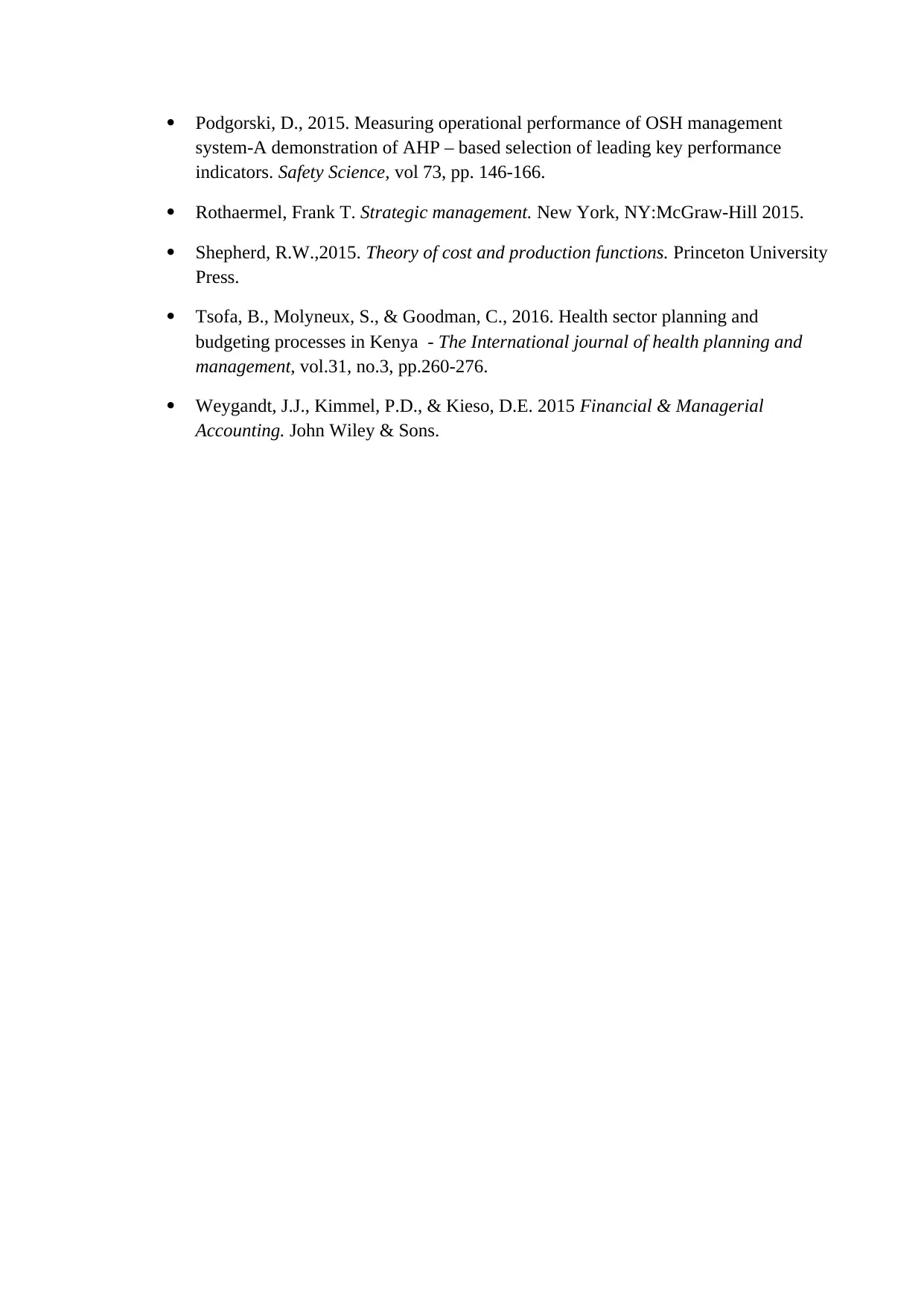
Podgorski, D., 2015. Measuring operational performance of OSH management
system-A demonstration of AHP – based selection of leading key performance
indicators. Safety Science, vol 73, pp. 146-166.
Rothaermel, Frank T. Strategic management. New York, NY:McGraw-Hill 2015.
Shepherd, R.W.,2015. Theory of cost and production functions. Princeton University
Press.
Tsofa, B., Molyneux, S., & Goodman, C., 2016. Health sector planning and
budgeting processes in Kenya - The International journal of health planning and
management, vol.31, no.3, pp.260-276.
Weygandt, J.J., Kimmel, P.D., & Kieso, D.E. 2015 Financial & Managerial
Accounting. John Wiley & Sons.
system-A demonstration of AHP – based selection of leading key performance
indicators. Safety Science, vol 73, pp. 146-166.
Rothaermel, Frank T. Strategic management. New York, NY:McGraw-Hill 2015.
Shepherd, R.W.,2015. Theory of cost and production functions. Princeton University
Press.
Tsofa, B., Molyneux, S., & Goodman, C., 2016. Health sector planning and
budgeting processes in Kenya - The International journal of health planning and
management, vol.31, no.3, pp.260-276.
Weygandt, J.J., Kimmel, P.D., & Kieso, D.E. 2015 Financial & Managerial
Accounting. John Wiley & Sons.
1 out of 21
Related Documents
Your All-in-One AI-Powered Toolkit for Academic Success.
+13062052269
info@desklib.com
Available 24*7 on WhatsApp / Email
![[object Object]](/_next/static/media/star-bottom.7253800d.svg)
Unlock your academic potential
© 2024 | Zucol Services PVT LTD | All rights reserved.





